Preserving the stories of significant individuals in sound recording generally and magnetic recording specifically is a major project of MOMSR. The Museum’s goal is to document the stories of those persons who contributed significant inventions, manufactured equipment and who engineered and produced audio recordings, especially in the areas of music, broadcast, film/video and science. These interviews will be available on MOMSR’s web site and in the permanent facility when it is created. These interviews have also been made available to the Audio Engineering Society (AES) and the National Academy of Recording Arts and Sciences (Grammy’s).
The BBC and EMI
 The Museum of Magnetic Sound Recording greatly appreciates Roger Wilmut, who worked for the BBC from the 1960's to 2000, for providing us with the following information on the BBC and EMI. This content was provided by Roger from his web site.
The Museum of Magnetic Sound Recording greatly appreciates Roger Wilmut, who worked for the BBC from the 1960's to 2000, for providing us with the following information on the BBC and EMI. This content was provided by Roger from his web site.
When the BBC was formed in 1922 there was no electrical recording system outside laboratories. Gramophone records were made by using a horn with a diaphram at the end of it, connected directly to the cutting stylus; electrical recording only came into use in 1925. The only recording in the BBC archives pre-dating this is of King George 5 opening the 1924 British Empire Exhibition, and this was made by an amateur pointing his radio speaker down a home-made acoustic recording machine.
 From 1925 the BBC had a few recordings made over landline by gramophone companies such as HMV or British Homophone. The recording had to be made on a wax blank, which was too soft for immediate playback and had to be electroplated to produce a stamper before playable records could be pressed, an expensive process which took at least twelve hours. This made it useless for repeating items, and was used very sparingly for important events such as royal speeches.
From 1925 the BBC had a few recordings made over landline by gramophone companies such as HMV or British Homophone. The recording had to be made on a wax blank, which was too soft for immediate playback and had to be electroplated to produce a stamper before playable records could be pressed, an expensive process which took at least twelve hours. This made it useless for repeating items, and was used very sparingly for important events such as royal speeches.
All broadcasting was done 'live' - this was part of the attraction since listeners knew that what they were hearing was happening now. Radio plays which were repeated had to be performed again, as did any features or musical programmes. Only gradually as viable recording methods were developed did the use of recordings for repeats, or for internal listening to assess the success of a programme, become possible.
As a BBC Engineer and then Studio Manager from 1961-2007 I saw some of these developments take place:
and though obviously I had no contact with the earlier systems I did work with people who had used them or worked with people who did: so I can comment on some of the history from my own experience.
Magnetic recording had been around since Valdemar Poulsen's 'Telegraphone' of 1899 - a wire recorder without amplification (the carbon microphone - as used in telephones - was connected directly to the recording head) which could just about drive headphones. However there were many technical difficulties, and it was not until the late 1920s that a moderately practicable magnetic recorder was developed in Germany.
This was the Blatterphone (left), which used 6mm wide steel tape travelling at 5 feet per second: the large reels allowed for 20 minutes of continuous recording and, importantly for the BBC, once the recording had been rewound it could be played back without further processing. The first machine was installed in 1930 and later joined by a second; in September 1932 a new version using 3mm wide tape and allowing for 30 minutes recording became available.
A major use for the machines was for the Empire Service, which started in 1932, and often required programmes to be broadcast in the middle of the night; the Blattnerphone allowed these to be recorded in advance. However there were many problems. The speed was unstable, the sound quality was hissy and lacking in top, and both the heads and the tape could break easily. Editing was possible, though this required either a soldering iron or a spot-welder and left an audible plop as the joint passed through, so it was rarely done.
Despite the problems, the machines proved useful, though the majority of broadcasts continued to be live. By 1935 a new machine had been developed, the Marconi-Stille, 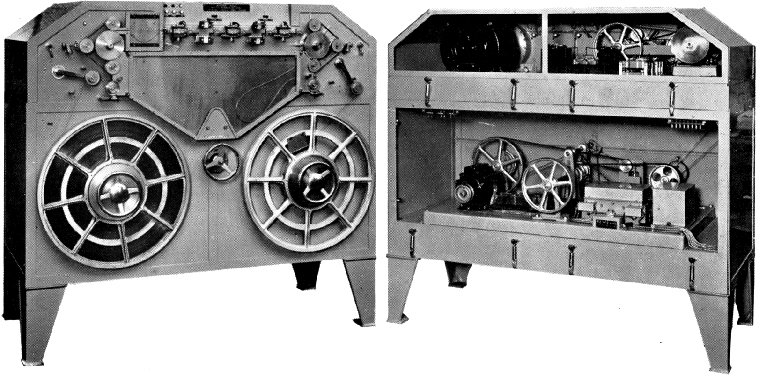 using the same principles but with advanced techniques to attempt to address the problems of the Blattnerphone.
using the same principles but with advanced techniques to attempt to address the problems of the Blattnerphone.
The quality was slightly improved, though it still tended to be obvious that one was listening to a recording, as was the reliability. A reservoir system containing a loop of tape (seen above the right-hand spool in the picture, above left) helped to stabilize the speed (there was also a smaller one just before the heads). The tape was 3mm wide and travelled at 1.5 metres/second. The first one was installed at Maida Vale in March 1935 and by September there were three recording rooms, each with two machines.
They were hardly easy to handle. The spools were heavy (and expensive) and the tape has been described to me as being like a travelling razor blade: I was told that several people lost the tips of fingers through incautious handling. The tape was liable to snap, particularly at joints, which at that speed could rapidly cover the floor with loops of the sharp-edged tape. Rewinding was done at twice the speed of the recording: apparently one occasion a reel came loose, bounced on the floor and went straight through a partition wall.
However despite all this the ability to make replayable recordings was extremely useful, and even with subsequent methods coming into use the Marconi-Stilles remained in use until the late 1940s.
From the mid 1930s two further methods slowly came into use: film and disc.
Optical Films
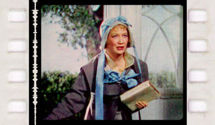 Cinema films were made with sound from the end of the 1920s; disk and optical recording ran side-by-side for a time, but the advantages of optical were considerable, particularly in editing, and in that the track was on the projection print alongside the picture and so couldn't get lost or out of synchronization. Though the quality could be noisy at first, it was rapidly improved.
Cinema films were made with sound from the end of the 1920s; disk and optical recording ran side-by-side for a time, but the advantages of optical were considerable, particularly in editing, and in that the track was on the projection print alongside the picture and so couldn't get lost or out of synchronization. Though the quality could be noisy at first, it was rapidly improved.
There were a few stand-alone optical recorders, such as the Selenophone which used 35mm film sliced to leave just the sound-track and adjacent sprockets, and was used for recording the 1937 Salzburg Festival opera performances (not by the BBC). However the system was not really suitable for broadcasting as the film had to be developed, causing delays, and the quality was mediocre.
The BBC became interested in a development by the Dutch Philips company, the Philips-Miller optical recorder. Instead of using 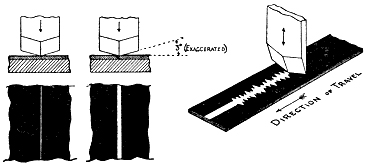 photographic techniques, this used film stock coated with a clear layer of gelatine with a thin opaque covering. A stylus with a wide angle moved vertically and cut away the opaque layer to make a variable-area soundtrack; this could be played back immediately using a light beam and a photoelectric cell (the same as for a photo-optical recording). The film travelled at 32 cm/second (fractionally over 12½ inches/second).
photographic techniques, this used film stock coated with a clear layer of gelatine with a thin opaque covering. A stylus with a wide angle moved vertically and cut away the opaque layer to make a variable-area soundtrack; this could be played back immediately using a light beam and a photoelectric cell (the same as for a photo-optical recording). The film travelled at 32 cm/second (fractionally over 12½ inches/second).
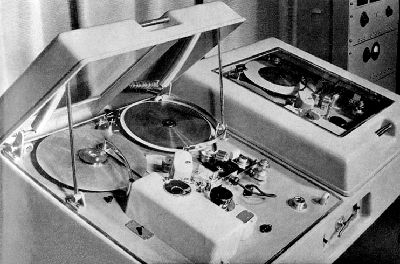 Both the machines and the reels of film were a much more practicable size than the Marconi-Stille, the film could be easily edited (using film cement, as with cinema film), and though there was still some background noise the quality was quite good. The BBC started experimenting with this system in 1935 and it gradually came into use.
Both the machines and the reels of film were a much more practicable size than the Marconi-Stille, the film could be easily edited (using film cement, as with cinema film), and though there was still some background noise the quality was quite good. The BBC started experimenting with this system in 1935 and it gradually came into use.
With the onset of the war in 1939 the ability to make recordings suddenly became much more important. The concept of a programme appearing on the same day of the week became normal for the first time, because of the expected difficulty in distributing the Radio Times. Programmes such as the immensely popular ITMA were performed live but recorded on Philips-Miller for subsequent repeat - up to then Variety and similar programmes had not normally been repeated, and with the difficulties caused by the war a second chance to hear a programme became important.
There were difficulties in obtaining the film stock during wartime, and two methods were used to eke it out - programmes where a lower quality could be accepted were recorded at 20 cm/sec; and there was enough space to record two tracks (separately) side-by-side. I believe some were even made with three, though this would pose a danger of peaks on one track breaking through into the adjacent one (and I've heard something suspiciously like this on recordings).
The surviving wartime ITMAs were all recorded on (and have since been transferred from) Philips-Miller, as was the very ambitious Louis MacNeice play Christopher Columbus, performed live in 1942 and involving multiple studios, a huge cast, a chorus and the BBC Symphony Orchestra.
Though reasonably reliable the machines did require skilled handling; because the cutting stylus had to be exactly made, when engineers found one that worked well they tended to appropriate it and carry it for their own use. The system continued through into the post-war period but fell out of use by the end of the 1940s.
At the same time as the Philips-Miller was coming into use, a new method of disk recording was developed.
Directly Cut Disks
 The normal method of producing gramophone records was not suitable for the BBC because of the long delay before a playable copy could be made (and the cost). From the early 1930s a British inventor, Cecil Watts, was working on a form of disk which could be played back immediately: by 1934 he had a workable method involving a lacquer coating on an aluminium disk and was running a firm called M.S.S. to manufacture them and the disk-cutters. The blanks could be cut in the same way as wax blanks had been, but could be played back immediately - though obviously the lacquer was much softer than a normal gramophone record and repeated playings would wear it much more quickly. The BBC started experimenting with this: at first there were difficulties because of the quality of the lacquer but eventually things settled down and the system came into regular use. The photo shows a M.S.S. disk-cutting channel, the first type the BBC used.
The normal method of producing gramophone records was not suitable for the BBC because of the long delay before a playable copy could be made (and the cost). From the early 1930s a British inventor, Cecil Watts, was working on a form of disk which could be played back immediately: by 1934 he had a workable method involving a lacquer coating on an aluminium disk and was running a firm called M.S.S. to manufacture them and the disk-cutters. The blanks could be cut in the same way as wax blanks had been, but could be played back immediately - though obviously the lacquer was much softer than a normal gramophone record and repeated playings would wear it much more quickly. The BBC started experimenting with this: at first there were difficulties because of the quality of the lacquer but eventually things settled down and the system came into regular use. The photo shows a M.S.S. disk-cutting channel, the first type the BBC used.
The process was more suited to short items than full-length programmes - though it was perfectly possible, with two machines, to change 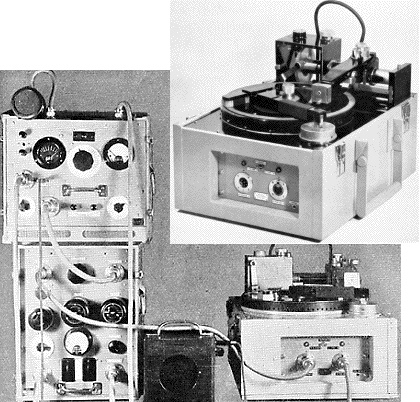 over, recording a 30 second overlap.
over, recording a 30 second overlap.
On playback the engineer would start the second disk, listening on headphones, pull it into sync by spinning or holding back the turntable (which wasn't heavy) and changing over once the two matched: though requiring some skill it isn't as impossible a task as it sounds (I've done it myself).
Disk recording was particularly suited to making location recordings, and the model C disk-cutter (right) was developed; this could be carried in an ordinary car and used to record interviews and so on. (This would be termed a 'transportable' machine, i.e. not actually bolted down: truly 'portable' machines would mean capable of being carried by one person).
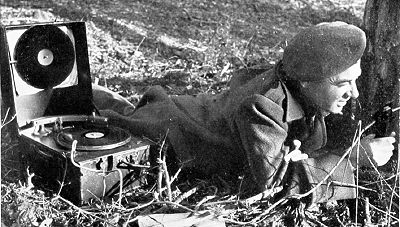 With the onset of the war came a requirement for reporters in battle zones to be able to record reports. and so the BBC midget recorder was developed. This was truly portable, though still very heavy, and used a clockwork spring - as used in ordinary wind-up gramophones - to drive the turntable, thus removing a lot of strain from the battery (which still of course had to power a valve amplifier). The photo shows Frank Gillard using one in action.
With the onset of the war came a requirement for reporters in battle zones to be able to record reports. and so the BBC midget recorder was developed. This was truly portable, though still very heavy, and used a clockwork spring - as used in ordinary wind-up gramophones - to drive the turntable, thus removing a lot of strain from the battery (which still of course had to power a valve amplifier). The photo shows Frank Gillard using one in action.
The onset of the war was also a driving force in the development of the disk recording. In 1941 a number of American Presto machines (below) were provided by the USA under lease-lend (some of these were intercepted and landed up at the bottom of the Atlantic). Many of these were for the Overseas Service at Bush House and were still in use over twenty years later: I cut a large number of disks on these as a young Engineer. The quality was surprisingly good - in fact better than 15 inches-per-second tape on the first play, though they did sound noisier once the producer had taken them to his office and played them a few times.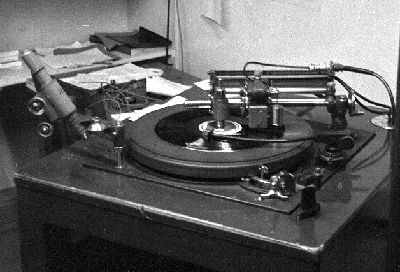
The recording channels posed a safety risk: though for some reason normally referred to as 'acetates' the lacquer was in fact cellulose nitrate - the same as non-safety cinema film. When you cut a disk the off-cut comes off as a ribbon, called swarf. Although the cellulose nitrate is safe enough when it's on the base, because this swarf is mixed with air it is extremely inflammable. When I was on the training course at Evesham the lecturer took a handful of the stuff outside onto the concrete and dropped a match on it (I suspect this was to discourage us from trying it). It went up immediately in six feet of flame, and I could feel the heat on my face ten feet away - it's that dangerous.
There is a legend that, at the BBC Studios in Oxford Street (which closed in 1957) a producer (later a well-known politician) knocked his pipe out in a bin marked 'fire' (thinking it contained sand) and the swarf in it set fire to the recording channel. At Bush House another producer dropped a match (which had gone out but was still warm) in a bin - this time the engineer had the presence of mind to put his foot on the bin, so there was no fire, but the fumes got into the ventilation system and caused the evacuation of the entire floor.
One of the cleaners saw some of this soft black stuff and took it home and stuffed a cushion with it... very fortunately someone found out about it and she was discouraged. She might as well have taken an incendiary bomb home - if someone had ignited it, it would have burned her house down.
The Prestos served us well, and were still working reliably when they were phased out in the mid-1960s; we also had several BBC Type D disk-cutting channels, and though 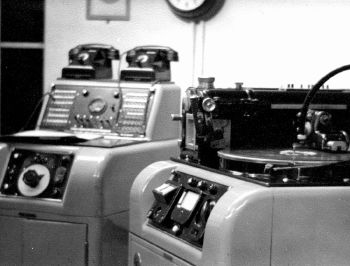 these were no better in the already very good quality of the finished result, they were much easier to handle, with a better vacuum-clearance of swarf than the Prestos, push-button scrolling rather than a handle to turn, and much easier line-up. (In both cases not only did test cuts with a fixed-frequency tone have to be made to get the level right, but the grooves had to be examined with a microscope as you cut the test so that you could adjust the depth of cut).
these were no better in the already very good quality of the finished result, they were much easier to handle, with a better vacuum-clearance of swarf than the Prestos, push-button scrolling rather than a handle to turn, and much easier line-up. (In both cases not only did test cuts with a fixed-frequency tone have to be made to get the level right, but the grooves had to be examined with a microscope as you cut the test so that you could adjust the depth of cut).
Almost all these recordings were made at 78rpm. There had been some use of 60rpm in the early days but this had been abandoned. Indeed the 1950 BBC Recording Training Manual devotes two pages to a mathematical proof that recording at 54rpm increases the maximum time without degrading the quality, before concluding that as commercial recordings are made at 78rpm it's better to stick at that. Recordings were also made at 331/3rpm on 17 inch disks (using the same sized grooves as 78rpm): as 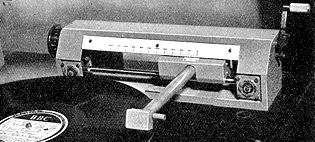 one side would hold ten minutes this system was widely used at Broadcasting House for recording complete programmes.
one side would hold ten minutes this system was widely used at Broadcasting House for recording complete programmes.
Another reason for the continued use of disks was that up until the late 1960s there were no tape machines in studios: disks could be taken to the studio and played by Studio Managers (usually using the TD7 player with its groove locating mechanism - left), but tape inserts had to be played remotely from a central tape room. Tape had been in use for many years for longer recordings, but with the introduction of smaller tape machines into studios (and the increased reliability of tape which meant that an engineer's attendance wasn't necessary) the disk system was phased out.
Magnetic Tape
Steel tape had proved useful, but was awkward and not of the best sound quality. During the war, monitors became aware that the Germans were evidently able to make high-quality recordings, since Hitler's speeches were being broadcast at all hours in what sounded like 'live' quality: during the invasion a number of radio stations were captured, equipped with recorders using ¼-inch tape on a cellulose acetate base, coated with a fine layer of iron oxide (Fe2O3) - paper had been in use as a base just before the war but broke so easily that it was impracticable.
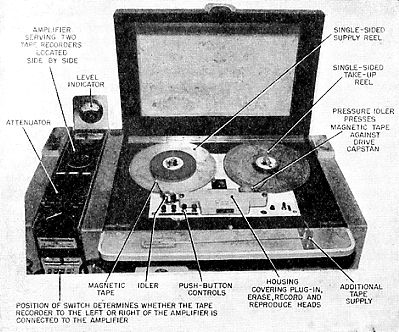 The BBC acquired some Magnetophone machines (left) in 1946 on an experimental basis, and these were used in the early stages of the new Third Programme to record and playback performances of operas from Germany (live relays being problematic because of the unreliability of the landlines in the immediate post-war period). The tapes ran at 30 inches/second (ips), and the flexible base provided much better contact with the head: the main reason for the improvement in the sound was the addition of a high-frequency current at 100kHz to the audio signal, which avoided the inherent distortion in the magnetization process.
The BBC acquired some Magnetophone machines (left) in 1946 on an experimental basis, and these were used in the early stages of the new Third Programme to record and playback performances of operas from Germany (live relays being problematic because of the unreliability of the landlines in the immediate post-war period). The tapes ran at 30 inches/second (ips), and the flexible base provided much better contact with the head: the main reason for the improvement in the sound was the addition of a high-frequency current at 100kHz to the audio signal, which avoided the inherent distortion in the magnetization process.
These machines were used until 1952, though most of the work continued to be done using the established media; but from 1948 a new British model became available from EMI: the BTR1. Though in many ways clumsy, its quality was good, and as it wasn't possible to 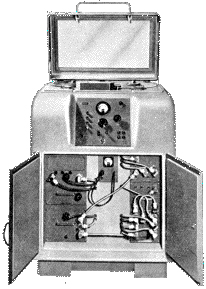 obtain any more Magnetophones it was an obvious choice. There was some difficulty with the tape: early EMI tape was very prone to print-through (where the magnetic image on one layer causes the next layer on the spool to pick up a faint version, causing pre- and post-echoes, often through several layers) - I've been told that the BBC told EMI to sort this out or they would stop using tape. The effect remained in later years, but much diminished and normally not a serious problem.
obtain any more Magnetophones it was an obvious choice. There was some difficulty with the tape: early EMI tape was very prone to print-through (where the magnetic image on one layer causes the next layer on the spool to pick up a faint version, causing pre- and post-echoes, often through several layers) - I've been told that the BBC told EMI to sort this out or they would stop using tape. The effect remained in later years, but much diminished and normally not a serious problem.
 We still had one of the BTR1s in the 1960s and I've had the doubtful pleasure of using it. It was rather a nightmare: the operating buttons were connected to the mechanics by Bowden cable and were stiff, so you rapidly got a sore thumb. Worse, the head-block, because of its size, had to be outside the tape path with the heads facing away from you (and the tape wound oxide-out) so that marking the tape with a chinagraph pencil involved leaning over - I'm six feet tall and I found it awkward: shorter colleagues found it nearly impossible. In the early days, at 30 ips, people probably just grabbed the tape and cut it - at that speed you could afford to miss by a couple of inches as long as you weren't doing music editing. (Early editing was done by holding the tape in mid-air and using scissors - I once asked a colleague who had done this how he managed to get the angle consistent: he said, 'Oh, we didn't bother'. Of course at 30 ips it wouldn't matter much, but one of my more eccentric colleagues insisted on using scissors at 7½ ips, and his joints were a menace.)
We still had one of the BTR1s in the 1960s and I've had the doubtful pleasure of using it. It was rather a nightmare: the operating buttons were connected to the mechanics by Bowden cable and were stiff, so you rapidly got a sore thumb. Worse, the head-block, because of its size, had to be outside the tape path with the heads facing away from you (and the tape wound oxide-out) so that marking the tape with a chinagraph pencil involved leaning over - I'm six feet tall and I found it awkward: shorter colleagues found it nearly impossible. In the early days, at 30 ips, people probably just grabbed the tape and cut it - at that speed you could afford to miss by a couple of inches as long as you weren't doing music editing. (Early editing was done by holding the tape in mid-air and using scissors - I once asked a colleague who had done this how he managed to get the angle consistent: he said, 'Oh, we didn't bother'. Of course at 30 ips it wouldn't matter much, but one of my more eccentric colleagues insisted on using scissors at 7½ ips, and his joints were a menace.)
In the early 1950s the EMI BTR 2 became available (right); a much improved machine and generally liked. It became the standard in recording channels (rooms) for many 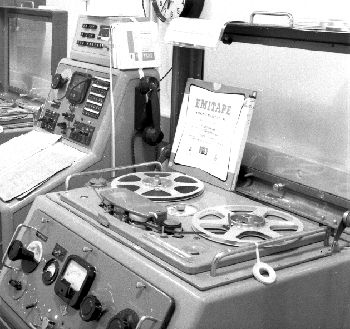 years, and was in use until the end of the 1960s. The machines were responsive, could run up to speed quite quickly, had light-touch operating buttons, forward-facing heads, and were quick and easy to do the finest editing on.
years, and was in use until the end of the 1960s. The machines were responsive, could run up to speed quite quickly, had light-touch operating buttons, forward-facing heads, and were quick and easy to do the finest editing on.
The tape speed was eventually standardized at 15 ips for almost all work at Broadcasting House, and at 15 ips for music and 7½ ips for speech at Bush House. The acetate base was replaced by PVC which broke less easily (though when it did it stretched, whereas acetate snapped cleanly and was easy to repair: stretched PVC was a disaster). The standard 10½ inch reels ran for half an hour at 15 ips with standard thickness tape (1.5 thousandths of an inch - 'long play' tape at 1 thousandth was available for domestic use but stretched too easily for broadcast use). In the end Bush House abandoned 15 ips for pretty well everything: and in 1971 embarked on an ill-advised experiment to use 3¾ ips to cut down on the considerable cost of tape. We all told them it wouldn't work: and it didn't - after a few weeks it was abandoned as the quality couldn't be maintained and joints tended to lift off the head in passing through.
 The BTR 1 and 2 revolutionized broadcasting. The quality was indistinguishable from live on transmission, and the finest editing could be done quickly and easily by practised engineers; instead of film cement or soldering irons the simple application of sticky tape to the edited tape held in a block made the process much simpler (right). Variety programmes could be recorded on Sunday, allowing the performers to appear in Music-Halls during the week, and the producer could edit the programme to tighten it up, get it to the correct length, and remove dubious jokes which had been slipped in (always a problem in the 1930s). The machines' speed reliability over 30 minutes was not perfect, so the tradition arose of programmes running 29 minutes and 30 seconds, with a 1 minute music play out, so that an error of ±30 seconds could be accommodated (this was before programme junctions were cluttered up with two minutes of trails).
The BTR 1 and 2 revolutionized broadcasting. The quality was indistinguishable from live on transmission, and the finest editing could be done quickly and easily by practised engineers; instead of film cement or soldering irons the simple application of sticky tape to the edited tape held in a block made the process much simpler (right). Variety programmes could be recorded on Sunday, allowing the performers to appear in Music-Halls during the week, and the producer could edit the programme to tighten it up, get it to the correct length, and remove dubious jokes which had been slipped in (always a problem in the 1930s). The machines' speed reliability over 30 minutes was not perfect, so the tradition arose of programmes running 29 minutes and 30 seconds, with a 1 minute music play out, so that an error of ±30 seconds could be accommodated (this was before programme junctions were cluttered up with two minutes of trails).
It also became normal to 'de-umm' pre-recorded interviews - particularly in the World Service where the interviewee was often not completely fluent in English: the most edits I ever had (I actually counted the number of pieces of sticky tape as they went past on-air) was 75 in a three-minute interview, though this was abnormally high.
Up until about 1965 there were no tape machines in studios: Studio Managers handled the mixing panel and played disks, but never touched tape - all recording, editing and playback was done in channels (except that occasionally at Broadcasting House a smaller tape machine was in use in the studio, but with an engineer in attendance. (Producers weren't allowed to handle tape either - the engineers sent recordings to a central library and all handling of tapes was carried out by Engineering Departm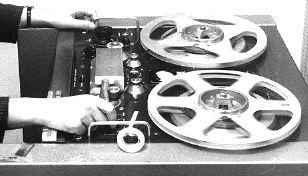 ent).
ent).
With the increased reliability of tape the decision was taken to equip studios with tape machines - initially for playback only, though eventually local recording was introduced and Studio Managers had to become fully conversant with the machines (there was some resistance to this as SMs were usually from a non-technical background). BTR2s were too big for studio use, and various other machines became available.
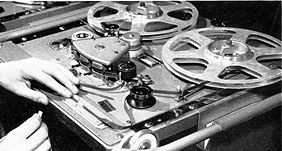 Broadcasting House used the EMI TR90 (left) and a Philips machine which was lightweight but very easy and quick to use: Bush House used the Leevers-Rich, initially in the widely-disliked Mark 2 version (right) but later with the push-button operated Mark 4 - which was an improvement, though the complicated tape lace-up path was still not popular.
Broadcasting House used the EMI TR90 (left) and a Philips machine which was lightweight but very easy and quick to use: Bush House used the Leevers-Rich, initially in the widely-disliked Mark 2 version (right) but later with the push-button operated Mark 4 - which was an improvement, though the complicated tape lace-up path was still not popular.
The Studer range of machines had become pretty well the studio recording industry standard by the 1970s, and gradually 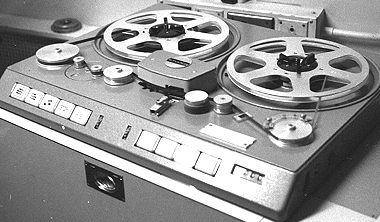 these replaced the aging BTR2s (which were now giving flutter and general reliability problems, with no spares available) in recording rooms and studios: the photo on the right is of the first model to arrive at Bush House, and later similar but refined versions were eventually installed in the larger studios. As delivered the machines had a motorized pair of scissors which popped out of a slot before the final roller, and was supposed to be used to edit the tape (you found the place then moved the tape on by an amount shown on the right-hand roller): it's a daft idea, and after someone had managed to snip a tape while it was being played up a line to Scotland (who thought it hilarious) the scissors were disabled to prevent further accidents.
these replaced the aging BTR2s (which were now giving flutter and general reliability problems, with no spares available) in recording rooms and studios: the photo on the right is of the first model to arrive at Bush House, and later similar but refined versions were eventually installed in the larger studios. As delivered the machines had a motorized pair of scissors which popped out of a slot before the final roller, and was supposed to be used to edit the tape (you found the place then moved the tape on by an amount shown on the right-hand roller): it's a daft idea, and after someone had managed to snip a tape while it was being played up a line to Scotland (who thought it hilarious) the scissors were disabled to prevent further accidents.
Gradually pre-recorded rather than live programmes - or inserts - became the norm. Recording in sections and subsequent editing and mixing enabled broadcast plays to be be assembled with less rehearsal, but something of the 'edge' of classic live plays such as Under Milk Wood and The Dark Tower was lost in the process. Of course there were new hazards: accidental erasure (fortunately not common, but it could happen: someone once placed a 4038 microphone - which contains a very powerful magnet - on top of a reel of tape, with obvious results), tapes dropped down lift-shafts or taken home in error (more than one Studio Manager has been woken in the night and told to bring a recording needed for overnight transmission back now), or stretched by mishandling (as an engineer I once saved an SM's skin by reconstructing the damaged word 'United' from syllables copied from elsewhere in the recording, and I don't claim any uniqueness about that).
So the advent of magnetic tape recording had more effect on radio than anything since its inception (and a similar process was taking place in television with the invention of video recording); and one of its major contributions was in providing the ability to make location recordings without lugging a car-load of touchy disk-cutting equipment about: portable recording will be examined on the next page.
Portable Recording
While before the advent of magnetic tape it had been possible to do mobile recording - involving a car-full of equipment - the only portable recorder had been the BBC midget disk recorder, used by war correspondents - and that was no light weight. With tape it became possible to make much smaller and lighter devices, with the aim of allowing a single non-technical member of staff to go out and make a location recording such as an interview without involving a lot of complex equipment.
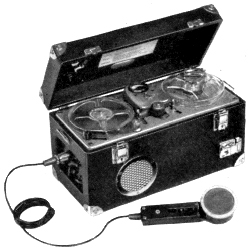 The EMI Midget (left) was the first practicable device of this type used by the BBC. Its size was 14 by 7 by 8 inches; initially using valves (later versions were transistorized with consequent savings on weight and battery usage) it recorded at 7½ips on five-inch spools (holding 15 minutes): it had no erase head so it was vital to use clean tape (more than one producer failed to pay attention to this point and brought back an unusable recording as a result).
The EMI Midget (left) was the first practicable device of this type used by the BBC. Its size was 14 by 7 by 8 inches; initially using valves (later versions were transistorized with consequent savings on weight and battery usage) it recorded at 7½ips on five-inch spools (holding 15 minutes): it had no erase head so it was vital to use clean tape (more than one producer failed to pay attention to this point and brought back an unusable recording as a result).
Two sets of batteries were required, nine dry cells lasting about 6 hours for 'low tension' (valve heaters) and motors, and two 67.5 dry batteries for the 'high tension' supply, lasting about 15 hours. The quality was very good, and the tapes - which were recorded full-track, as with studio machines - could be rewound onto larger spools for immediate editing or use in a studio.
This machine considerably increased the freedom of producers to obtain inserts such as interviews or background effects for features; but weighing in at 14½ lbs (6½kg) it was still quite a heavy object to carry any distance; so there was always a need for smaller high-quality machines.
The Uher portable (right) became available in the early 1960s and rapidly replaced the EMI as the machine of choice; it soon became standard issue. It recorded on 5 inch reels at speeds of 7½, 3¾, 17/8 and 15/16 ips, though obviously only 7½ was ever used by the BBC. It recorded half-track, like domestic machines, so it was advisable to use clean tape, and if both tracks of the tape were used it would have to be specially dubbed on return to the studio (this was before stereo: all studio machines were full track). The quality was excellent, though it was alarming how many producer-made recordings came back somewhat distorted.
A friend had his own Uher: on one occasion we were attempting to mimic the distorted sound of a producer-made recording for comic effect: we recorded so that the meter peaked well into the red overload area: and it sounded fine. So then we recorded with the meter never coming out of the red area: then it sounded like a producer-made recording.
The Uher was considerably lighter than the EMI at around 8lbs (3.6kg) but still heavy enough to make your shoulder ache if you carried it any distance; so there was always going to be a demand for really small machines. Unfortunately these tended to be domestic models with variable quality and poor reliability.
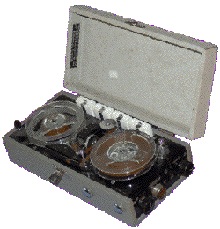 The Fi-Cord (left) was marketed from 1959 for domestic use: it was very small at 95/8 by 5 by 2¾ inches and weighed only 4½lbs (2kg). It used 3 inch spools containing long play (1 thousandth of an inch thick) tape which would run for eight minutes at 7½ips - the very thin tape needed careful handling and had to be dubbed on return to base as it couldn't be reliably edited or played in a studio. The quality was capable of being very good, but the machine was touchy and tricky to use. One producer brought me a tape which had been laced with a small amount sticking out underneath the reel: this had caused the machine to proceed in a series of jerks. He asked if I could use the variable-speed unit to correct this...
The Fi-Cord (left) was marketed from 1959 for domestic use: it was very small at 95/8 by 5 by 2¾ inches and weighed only 4½lbs (2kg). It used 3 inch spools containing long play (1 thousandth of an inch thick) tape which would run for eight minutes at 7½ips - the very thin tape needed careful handling and had to be dubbed on return to base as it couldn't be reliably edited or played in a studio. The quality was capable of being very good, but the machine was touchy and tricky to use. One producer brought me a tape which had been laced with a small amount sticking out underneath the reel: this had caused the machine to proceed in a series of jerks. He asked if I could use the variable-speed unit to correct this...
For this sort of reason the Fi-Cord never really caught on and had very little use. At the other end of the scale, for doing high-quality recordings without the need for a carload of gear, the Nagra (right) could be used, though as it was extremely expensive an engineer was required to go along to operate it. It was 14¼ by 9½ by 43/8 inches, and weighed almost 16lbs (so heavier even than the EMI midget). It could record at 15 ips as well as 7½ and 3¾ ips on 7 inch reels, thus making it more suitable for music, and its very high quality produced results well up to the standard of the best studio machines. Obviously it was suitable only for special occasions.
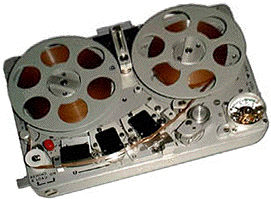 An interesting, if not very useful, development, was the Nagra SN (left), available from 1972, a sub-miniature machine built like a Swiss watch. It was less than 6 inches long, and used 2½ inch reels of 1/8 inch double-play tape (the same as used in Compact Cassette recorders) : there was no powered rewind. The machine would fit in a pocket and was capable of very high quality, but it was fiddly to use, and the tape could very easily be damaged; it never really caught on for broadcasting (although it was popular in America for security and covert surveillance work).
An interesting, if not very useful, development, was the Nagra SN (left), available from 1972, a sub-miniature machine built like a Swiss watch. It was less than 6 inches long, and used 2½ inch reels of 1/8 inch double-play tape (the same as used in Compact Cassette recorders) : there was no powered rewind. The machine would fit in a pocket and was capable of very high quality, but it was fiddly to use, and the tape could very easily be damaged; it never really caught on for broadcasting (although it was popular in America for security and covert surveillance work).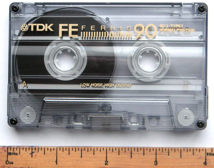
The ubiquitous Philips Compact Cassette (right), introduced in 1963, was more promising. Initially designed for dictation, it soon caught on for domestic use because of the ease of operation: but it was only the addition of Dolby 'B' noise reduction that made the quality anywhere near acceptable for professional use. The 1/8 inch tape travelled at the very slow speed of 17/8 ips, bringing problems of dirt pickup, alignment, tape noise and flutter. The alignment of the tape to the head depended on the enclosing cassette itself , and it was difficult to get a match between two different machines.
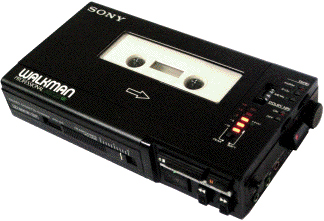 Some small and well-designed recorders were used for a time, particularly the Sony Walkman Pro (left), and were popular with producers as they were so easy to handle, but it was never an entirely suitable format for broadcasting (though full-sized machines were installed in studios to make reference recordings of transmissions, not for programme use but to be kept in case of queries).
Some small and well-designed recorders were used for a time, particularly the Sony Walkman Pro (left), and were popular with producers as they were so easy to handle, but it was never an entirely suitable format for broadcasting (though full-sized machines were installed in studios to make reference recordings of transmissions, not for programme use but to be kept in case of queries).
Sony pitched their MiniDisc system, introduced in 1992, as a replacement for the ageing Philips Cassette: it certainly had everything going for it. The small magneto-optical disks (right) were encased in a holder and easy to handle and load: the digital recording quality was excellent, despite the use of compression, and the disks could hold 75 minutes of high-quality stereo making them comparable to CDs. They never really caught on with the general public, though amateurs interested in high-quality recording found them a useful replacement for open-reel recorders. The recordings could even be edited, though it was a fiddly process.
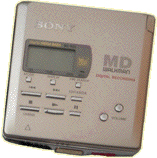 Small machines were available, having a footprint not much bigger than the disk itself; these were intended by Sony as replacements for the cassette 'Walkman' which had revolutionized personal listening (then came the iPod...): the top-level version of this range, which could also record, was used for a time by the BBC for portable recordings (left). The controls were fiddly, but the machines reasonably robust, without any of the difficulties experienced with the mini-Nagra, the Fi-Cord or cassettes. On the whole the results were successful and these machine saw some use until a completely new approach to recording came in in the 1990s.
Small machines were available, having a footprint not much bigger than the disk itself; these were intended by Sony as replacements for the cassette 'Walkman' which had revolutionized personal listening (then came the iPod...): the top-level version of this range, which could also record, was used for a time by the BBC for portable recordings (left). The controls were fiddly, but the machines reasonably robust, without any of the difficulties experienced with the mini-Nagra, the Fi-Cord or cassettes. On the whole the results were successful and these machine saw some use until a completely new approach to recording came in in the 1990s.
One disadvantage of all the above-mentioned machines except the EMI Midget and the large Nagra was that it was advisable - and in most cases 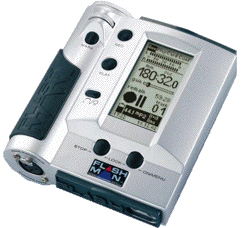 necessary - to take the time to copy the recording to normal open-reel tape before editing. The advent of digital systems opened new possibilities here, with a number of small digital recorders becoming available. Most were intended for dictation or note-taking, with mediocre quality: but the Mayah Flashman (right), introduced in 2002, took a fully professional approach to the idea. At 5 by 2¼ by 5¾ inches and weighing 715 grams (less than 2 lbs) it also had no moving parts, making it extremely robust.
necessary - to take the time to copy the recording to normal open-reel tape before editing. The advent of digital systems opened new possibilities here, with a number of small digital recorders becoming available. Most were intended for dictation or note-taking, with mediocre quality: but the Mayah Flashman (right), introduced in 2002, took a fully professional approach to the idea. At 5 by 2¼ by 5¾ inches and weighing 715 grams (less than 2 lbs) it also had no moving parts, making it extremely robust.
 It had an XLR connector for professional microphones, and recorded high-quality stereo in a variety of digital formats to a Compact Flash digital card (left): on return to base this card could be plugged into a computer with audio facilities and the recording transferred in a matter of seconds. The machine would record for 2½ hours and as it used standard AAA batteries it was an easy matter to carry spares and change them.
It had an XLR connector for professional microphones, and recorded high-quality stereo in a variety of digital formats to a Compact Flash digital card (left): on return to base this card could be plugged into a computer with audio facilities and the recording transferred in a matter of seconds. The machine would record for 2½ hours and as it used standard AAA batteries it was an easy matter to carry spares and change them.
Though it was comparatively expensive at around £1000 (its Mark 2 replacement is around twice that) its quality, robustness and ease of use made it an obvious choice and it came into widespread use.
By the time it came into use digital recording and playout facilities were well on the way to replacing tape across the BBC and other broadcasts: a major change in the process of recording.
Please view Roger Wilmut's information on later technology by visiting this link. And an excellent presentation on BBC and wireless technology by Roger.
The following photos and comments were made available to the Museum of magnetic Sound Recording by Roger Wilmut (BBC engineer from the 1960's to 2000)
Temporary Studio Equipment
When the BBC Overseas Service moved into Bush House at the start of the Second World War, there was a shortage of studio mixing desks because of the sudden expansion. As a stop-gap measure a number of 1938 vintage outside broadcast mixers - the OBA8 - were installed.
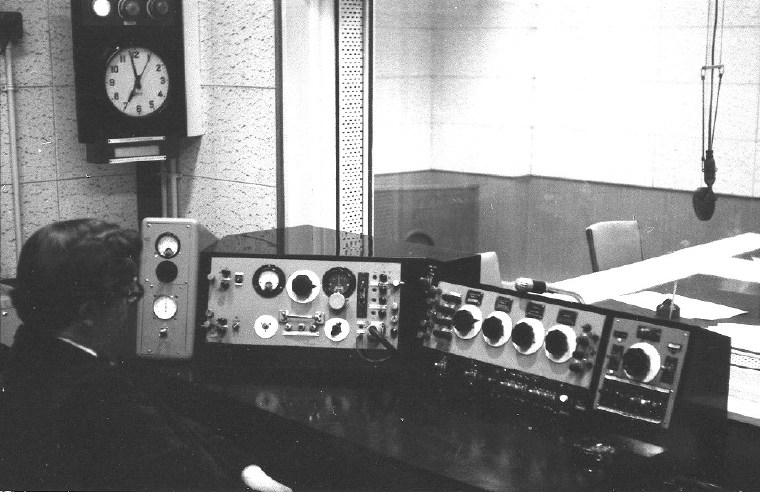
The BBC at that time made its equipment last... these desks were still in use thirty years later - I've made programmes on the wretched things, and I took the photo above in January 1969. The desk is much as it was when it was installed: the outrigger panel on the extreme left was added in the 1960s to accommodate the tape machines which were then being installed in studios. The small microphone over the mixer was added around that time for the Studio Manager to make the short announcement which preceded most transmissions (previously there had been a ribbon microphone slung over the gramophones). The microphone in the studio is an ST&C 4038 ribbon - when the desk was first installed it would probably have been the much larger AXBT ribbon microphone.
Although the main amplifier (valves, of course) was very good and much quieter than many later desk designs, the mixing was done at low level: that is, the microphone outputs were fed straight into the mixing controls without amplification, and the outputs of these controls mixed without the use of buffer amplifiers. The result was that not only were the controls very prone to noise when you moved them, but fading up one channel lowered the level of anything else faded up at the time.
To make working them more difficult, there was no transmission talkback, to allow the Studio Manager to talk to the studio while recorded inserts were being played. This led to considerable skills in mime as instructions were passed back and forth. Try asking someone 'which tape do you want next?' without being able to talk to them.
Starting around 1969 these desks were finally removed and replaced with Bush House's first transistorized desks, which brought their own set of interesting problems - that's another story.
BBC Formal Attire
You still hear people claiming that in the 1930s BBC news readers wore dinner jackets to read the news. This makes them sound silly and pompous: but the fact is that the news reader was also the Duty Officer, and welcomed visitors to Broadcasting House : they would have expected him to be properly dressed, and in those days 'properly dressed' in the evening meant dinner jackets, not an ordinary suit. It had nothing to do with the news.
Everyone else wore suits and ties, including the engineers buried away in the Control Room. To turn up in a sports jacket - or worse, without a tie - would have been considered completely unacceptable.
Even when I joined the BBC in 1961, working in the Control Room at Bush House, a certain formality of dress was still expected though suits were no longer expected. Even in Control Room (where we had no contact with the public or contributors) we were expected to wear jackets and ties. Indeed a memo came round every summer about not wearing open-necked shirts, couched in terms that made me want to take my tie off immediately.
When I became a Studio Manager in 1968 the general rule was that you should dress neatly, if not formally; though it was suggested that men should have a tie available in case they were asked to handle a programme including a visiting dignitary such as a foreign Prime Minister. Ladies were expected to wear skirts - trousers were allowed only on night shift.
As the years went on things were relaxed; nowadays people are simply expected to be reasonably tidy. Even Engineering Department became more relaxed. However some years back, when some formality was still demanded, one member of the Maintenance staff was told off for not dressing smartly enough. The next day he turned up in a kilt - he was Scots and the kilt bore the tartan of his Clan which he had a right to wear, and which was to him the correct formal dress. He wore this for some weeks: his bosses didn't like it, but there wasn't a thing they could do about it.
Roger Wilmut
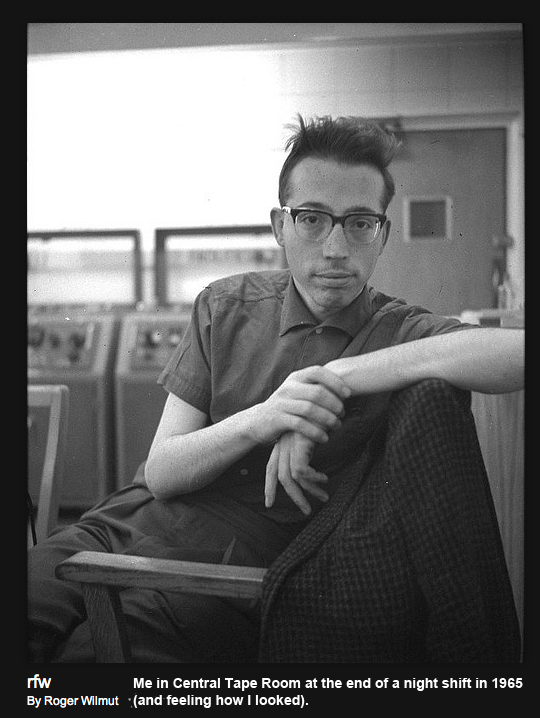
Me (Roger Wilmut) in Central Tape Room at the end of a night shift in 1965 (and feeling how I looked).
|
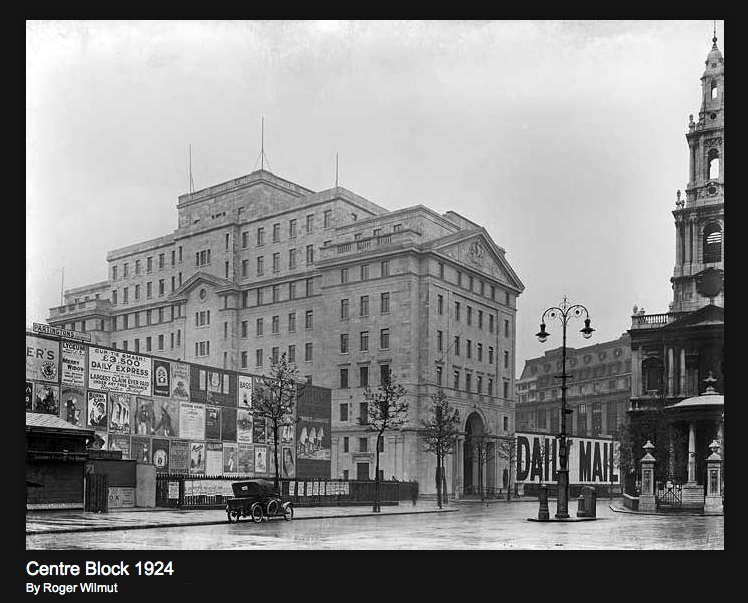
Centre Block 1924
Bush House under construction. I lifted this from a website, partleton.co.uk/Benjamin1839.htm
|
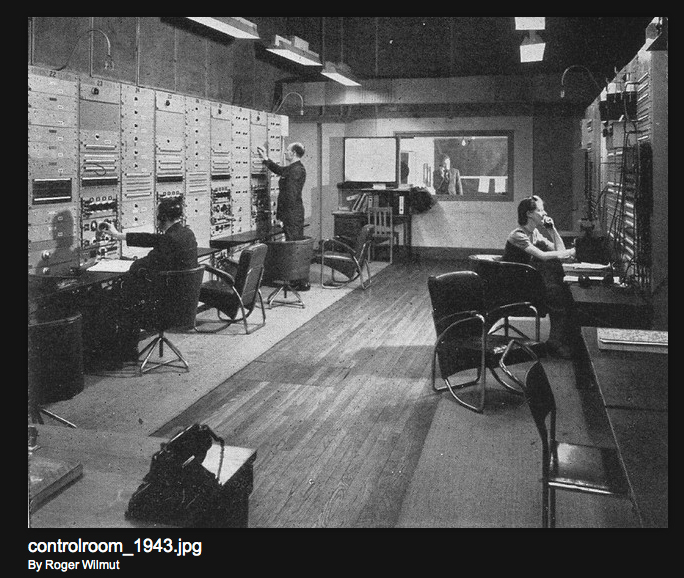
I found this photo in the 1943 Year Book; it's the European Control Room (European Services moved to Bush in 1941) in the area that is now S6.
|
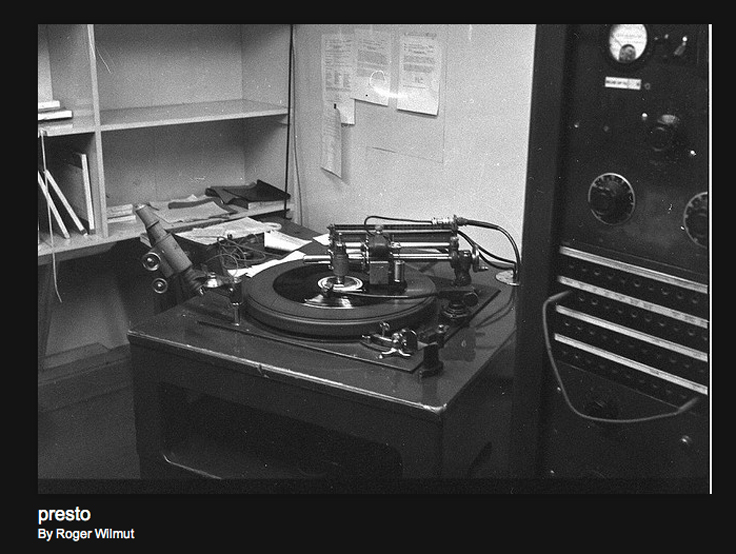
This photo of a Presto disc-cutting machine in a BBC recording channel at Bush House was taken on August 16th 1962. It was popularly believed that some of our Prestos came over under the wartime lend-lease system whereby America helped Britain during the Second World War, prior to its own involvement after Pearl Harbour - I don't know for sure whether this is true.
The cutter head can be seen to the right of the central spindle, moving along a lead screw. The crank handle on the right end of this is turned to increase the speed at which the head moves across the disk, for scrolls between items and the run-out at the end. The microscope is for examining the grooves to adjust the depth of cut. The tube running from above the head and to the right sucks the swarf (off-cut) away and into a safe bin (it was highly inflammable).
|
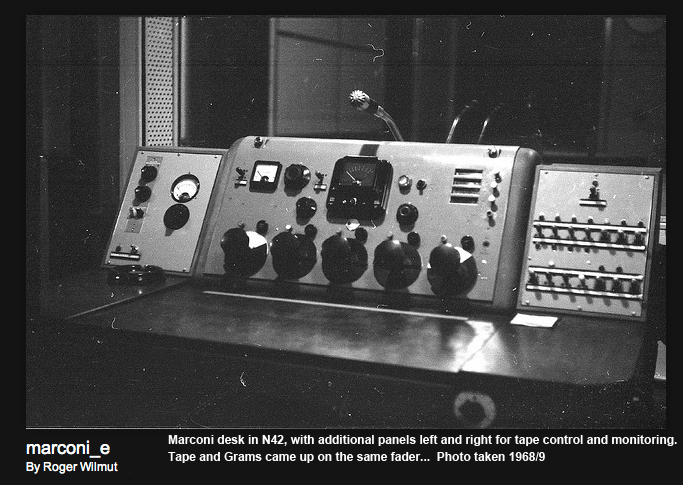
Marconi desk in N42, with additional panels left and right for tape control and monitoring. Tape and Grams came up on the same fader... Photo taken 1968/9
|
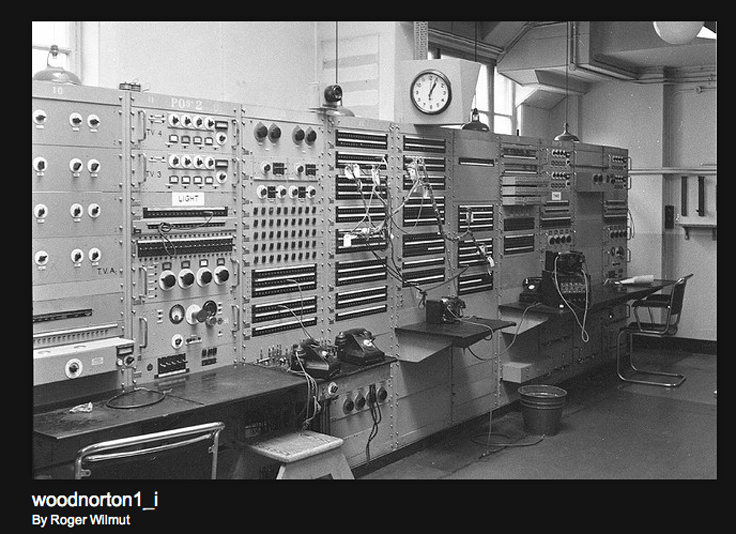
Engineering Training Department at Wood Norton - the Plug-and-Cord Control Room in 1962.
|
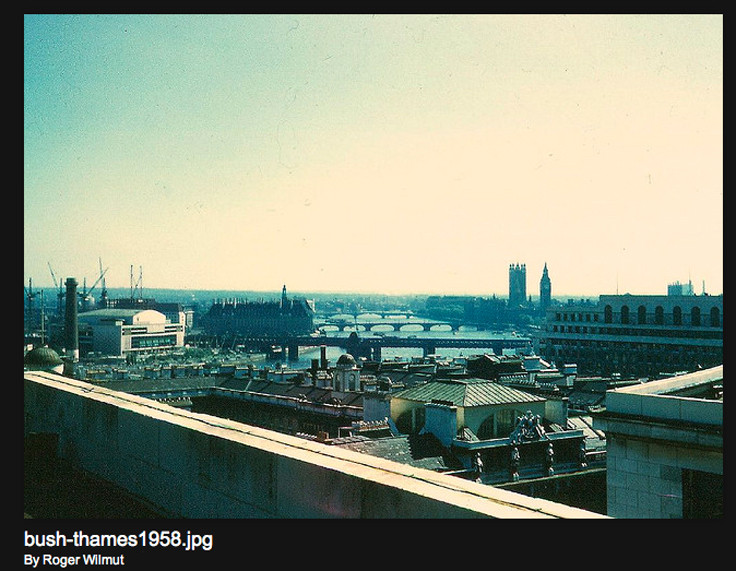
Allan Newman took this photo from the roof of Bush House in 1958 and has kindly given me permission to post it. On the left you can see the old shot tower, which was demolished to make way for the Queen Elizabeth Hall: the Shell Building has just begun construction.
|
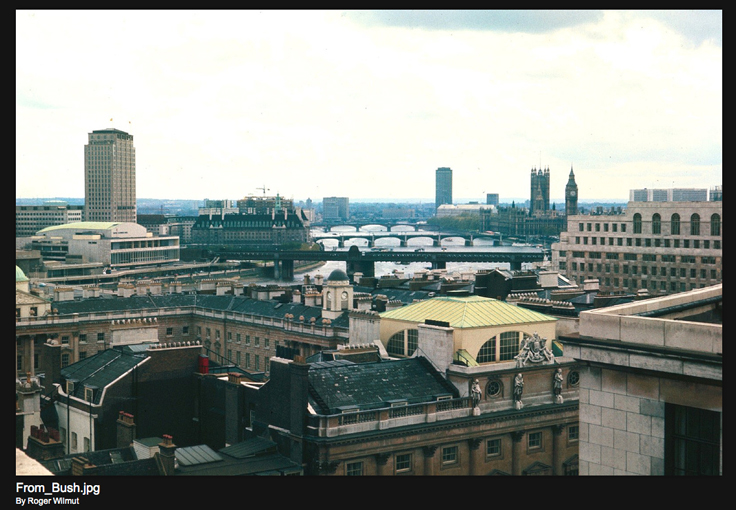
The view from the roof of Bush House, showing the river with Hungerford and Westminster Bridges, the Houses of Parliament, and the South Bank. Taken around 1970.
|
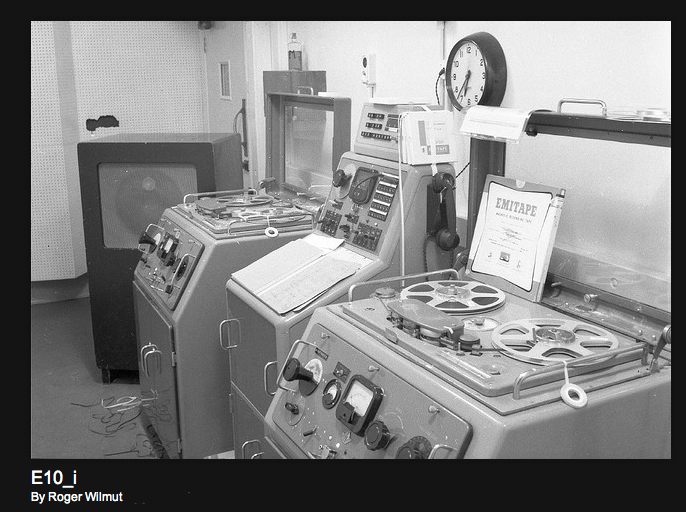
Recording channel E10 - two BTR2s and linking console. A 4 second exposure, which is why the clock appears to have no second hand. We all spent many hours in these poky channels. Taken in 1962
|
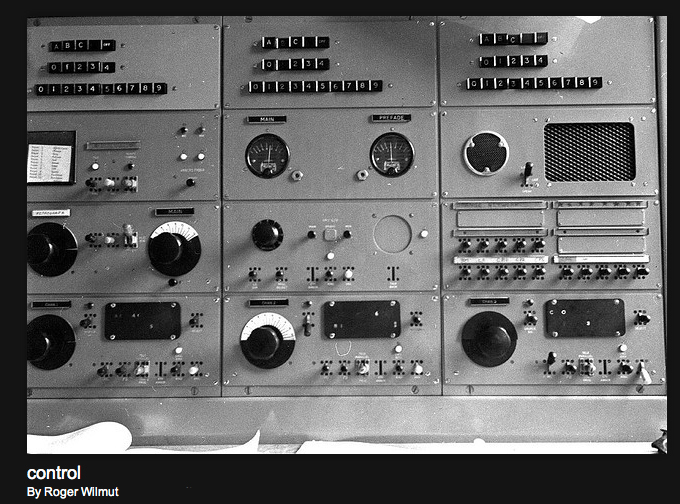
Continuity panel (the version without an announcer) in Control Room in 1962. Every network was monitored and controlled by an engineer, who put the studios on air, added Big Ben and GTS, and played tapes remotely into the transmission for longer items (short items were on disk). We even had to monitor the 15 minutes of tone preceding network opening. And not allowed to read anything (at least not during office house while the senior staff were in).
|
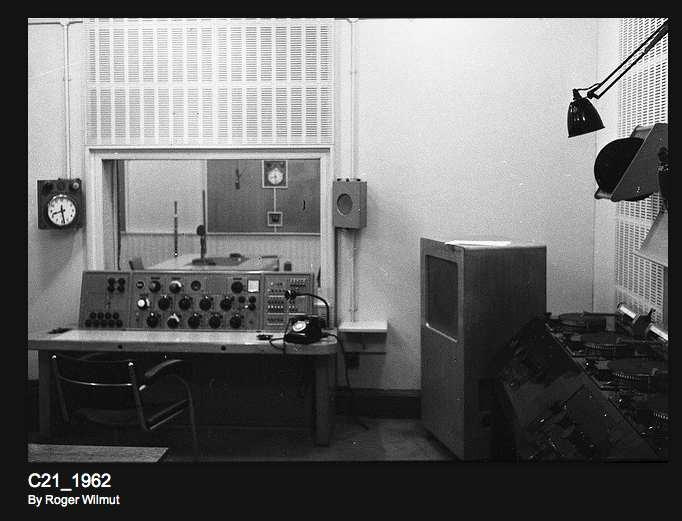
C21 on 19th February 1962. No tape machines in the studio, just grams (including a bank of RP/2s out of shot). Note no outriggers on the desk (RSA, etc). The monitor speaker is the classic LSU/10, with a 15 inch Tannoy unit plus a Lorenz tweeter, driven by a 12 watt valve amplifier and capable of producing deafening volume. Very clean sound, reasonably flat to 10kHz.
|
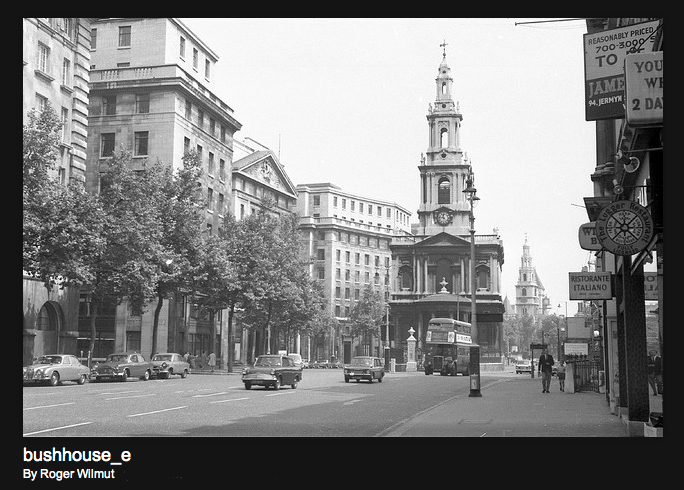
Bush House, home of the BBC World Service, in 1968/9
|
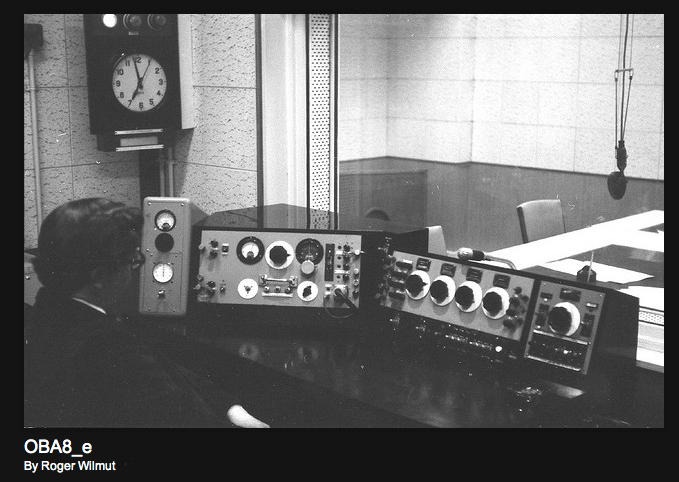
OBA8 - pre-war outside broadcast equipment, installed in Bush in a hurry at the outbreak of war and still in use 30 years later - this photo of S11 was taken in January 1969. Very limited facilities: no transmission talkback, passive mixing, so that opening a fader reduces the level on any other faders open at the time. However very low noise level from the main amplifier. The taller panel at the extreme left is a late addition to provide tape monitoring switching, a primitive meter for tape monitoring, and a stopwatch. Pete Wisbey presiding.
|
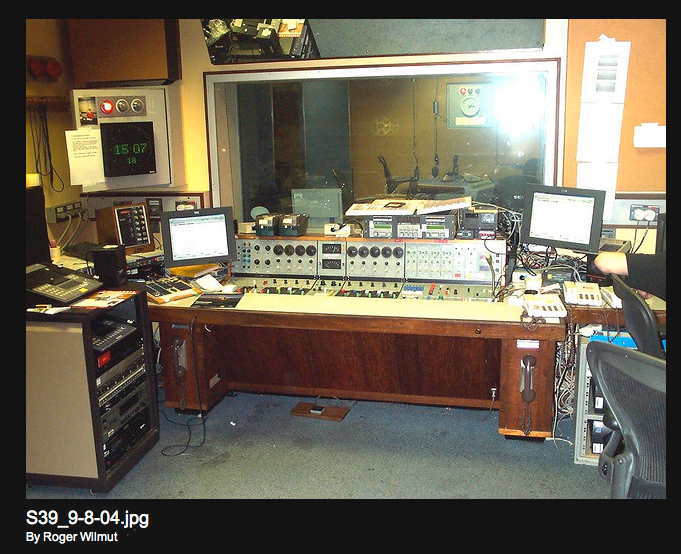
S39 before its recent complete refurbishment
|
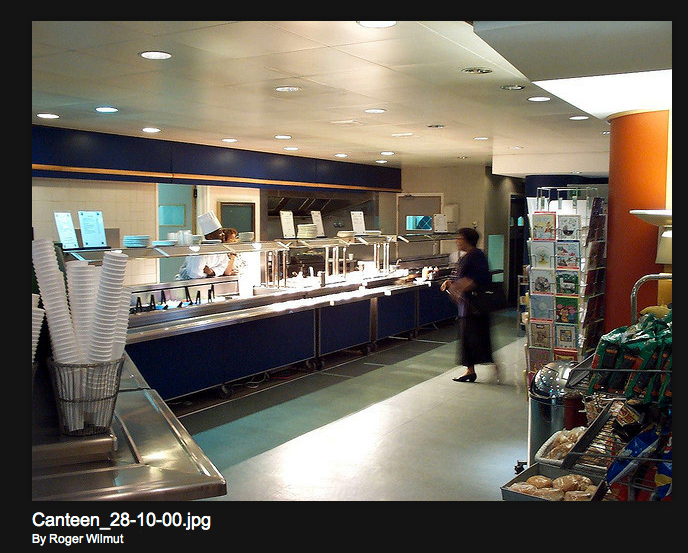
The Canteen on 28-10-00
|
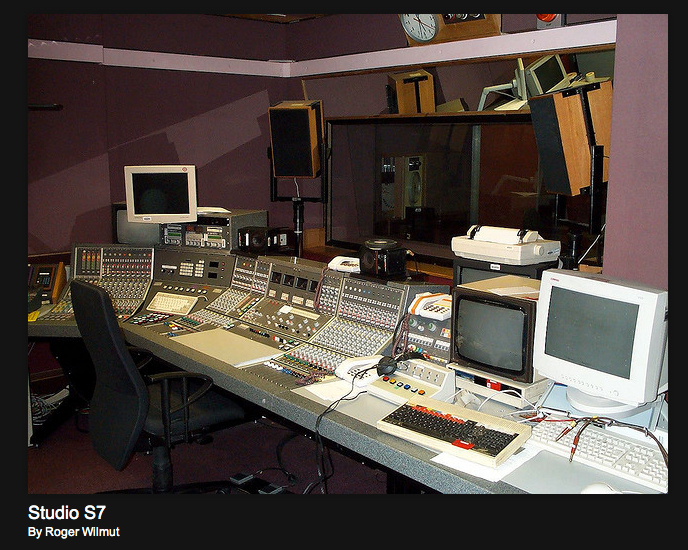
S7, Bush House, on 28-10-00 showing the GP desk. The ancient BBC computer on the right of the desk was used for sending details of questions to the presenter during phone-ins. The studio is equipped with the Dave 2000 digital playout system, since replaced by RadioMan.
|
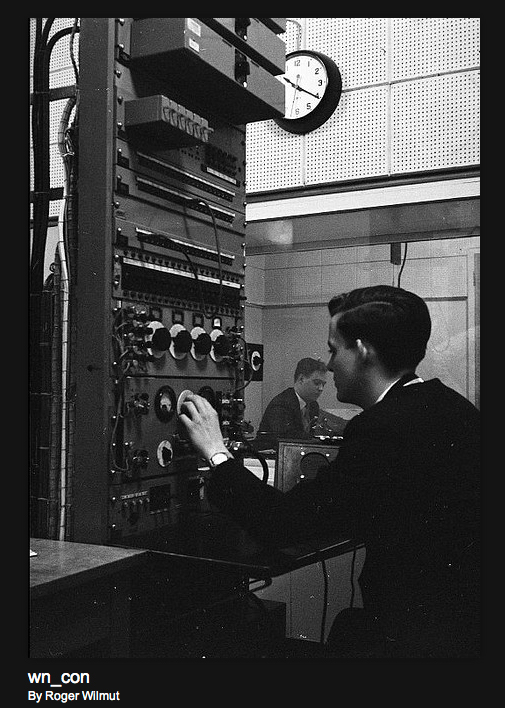
Wood Norton - training continuity studio.
|
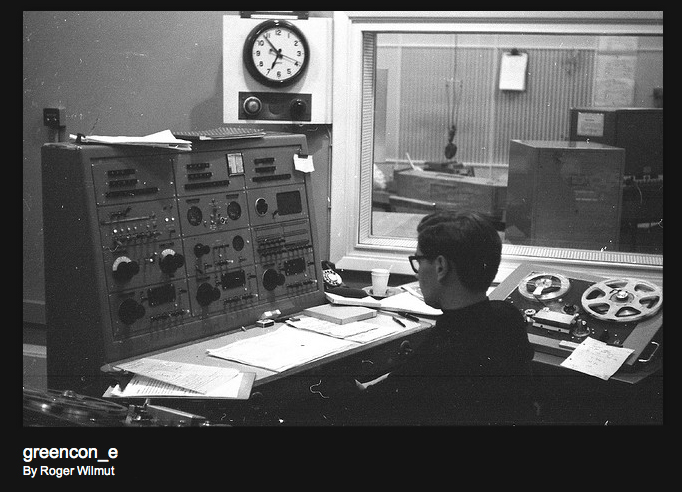
Green Continuity, Pete Wisbey presiding. Taken in 1968/9
|
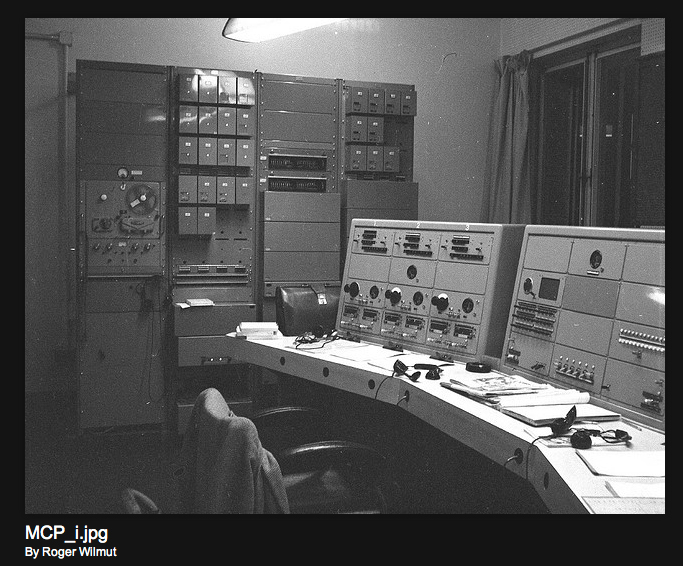
Another nightmare job: the multi-control position which replaced individual control positions for networks. This panel could handle six networks, with pre-programmed switching: sequential monitoring changed networks on the speaker every ten seconds and drove the operator mad. The Ferrograph on the bay was for making reference recordings, not for broadcast tapes. Photo taken in May 1966. MCP was replaced by studios going straight to line a few years later.
BushSM1967 - MCP was the worst place to be in at 5am towards the end of a night shift. Five of the six positions were operating so you got 10 second bursts of five languages. Most operators turned the volume very low so that it was just audible - it was silence you were looking out for, indicating something had gone wrong. One morning I was in the control room when one of the transmitters called to say they were getting English By Radio rather than Hungarian.I nipped into MCP to discover mayhem. The operator had somehow selected each studio to the wrong network so the Hungarians were getting EbyR, the Russians the French, the Hungarians the Russian & so on. It took a bit of working out to get everything back on course. The TOs log made interesting reading...
RW - As I remember, that was Tony Stirling - he logged it as 'due to the robotic and monotonous nature of the job', which didn't make him at all popular in the office. On another occasion he potted out of the WS news halfway through on the ID (and the announcer went into Commentaryg...) - he logged this as 'due to TO's over-quick reactions' (which coming from him....) it was also Tony who thumped Chas Chorley during an argument (couldn't have happened to a nicer man....)
|
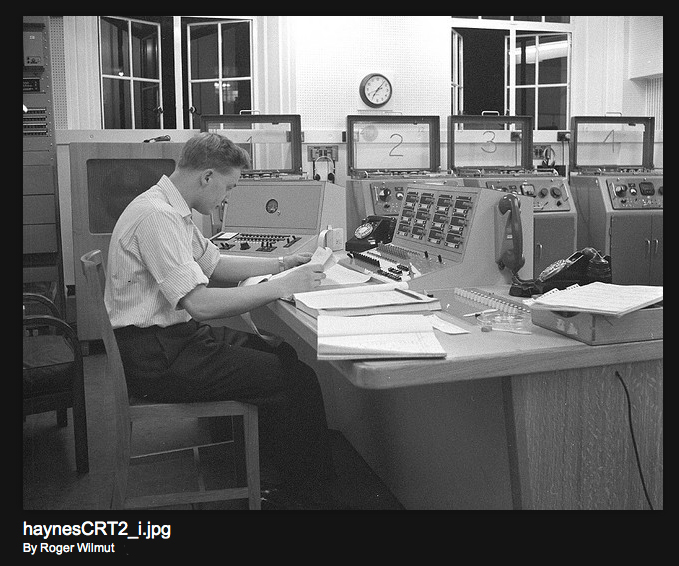
Central Tape Room 1 (CTR1) (later TOR). Originally studios, which had no tape machines, could remote-start tapes set up in here: later it was mostly used for recording and multi-copying. Alan Haynes is in charge: mid-1960s.
FTLD - When I worked at Bush as a graduate OP4 (1968-71), you could always find stashed away in CTR 15ips copies ot Pick of the Pops, Top Gear (John Peel), and other popular radio programmes recorded off the direct line from BH. These were easily copied onto "scrap" tape using the new high-speed duplicators installed in CTR around that time.
|
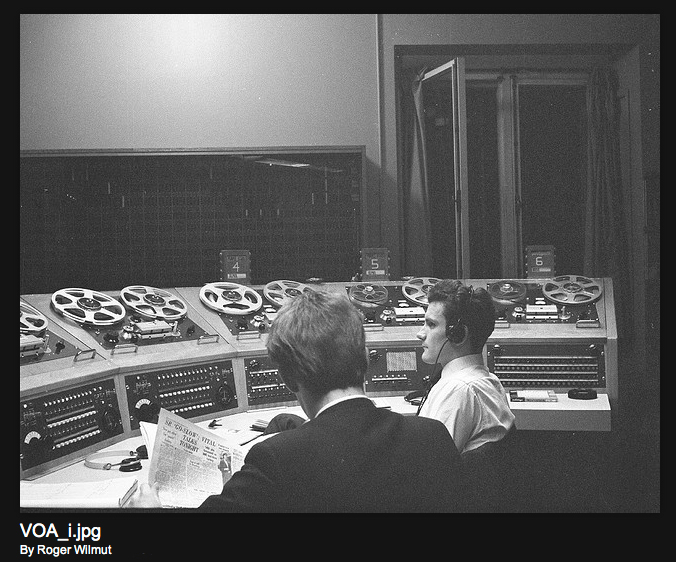
The Voice of America relay suite: the BBC relayed VOA short-wave broadcasts and played tapes of non-news programmes. Everything was automated and just had to be watched over and the tape machines loaded: boring in the extreme. The only bonus was the Sunday 'Voice of America Jazz Hour' presented by Willis Conover. Photograph taken 20th October 1964: Barrie Clarke and Mike Baker.
|
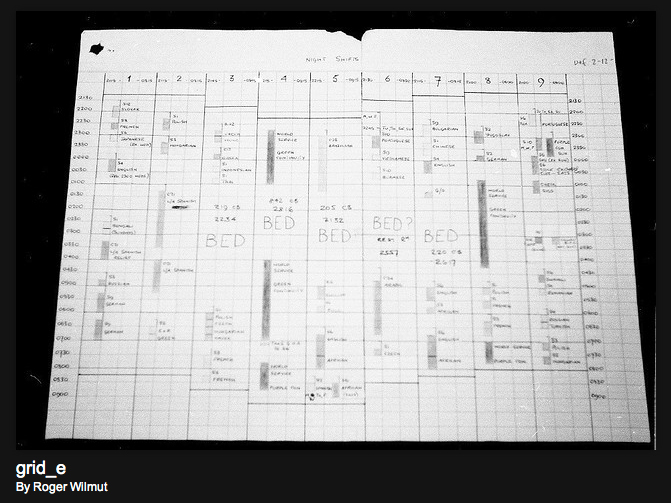
A night shift grid, 1968/9. Because it was photographed on a slant it's a bit unfocussed at the end - which is how I normally felt. And I remember we complained about this one...
|
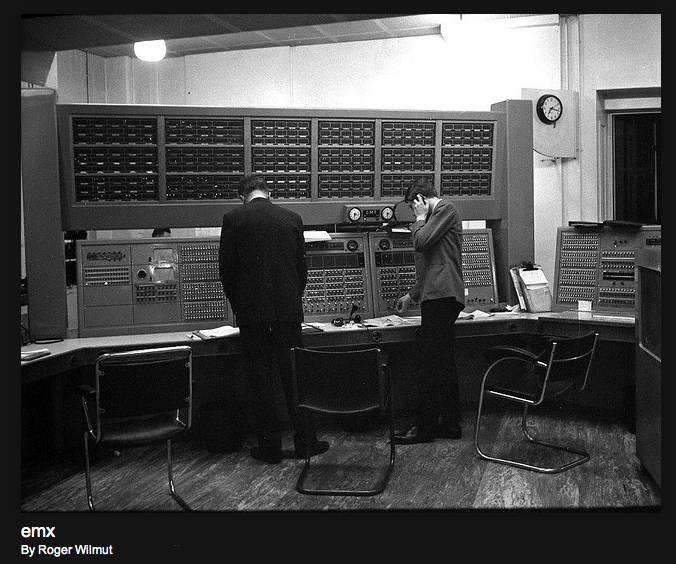
Control Room - EMX (Engineering Manual Exchange) in 1965.
|
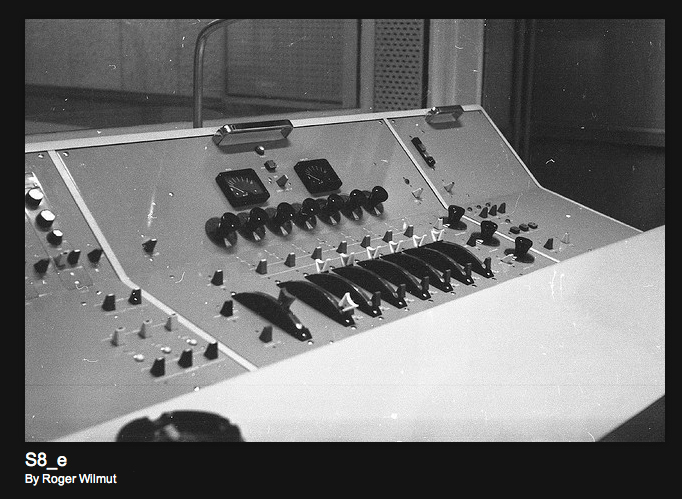
The first DK4/12, installed in S8. Widely disliked - hissy, a PPM with an inaccurate law, and quadrant faders that came apart in your hands if you weren't careful. Its successor, the DK4/19, was much more successful. Photo taken 1968/9
|
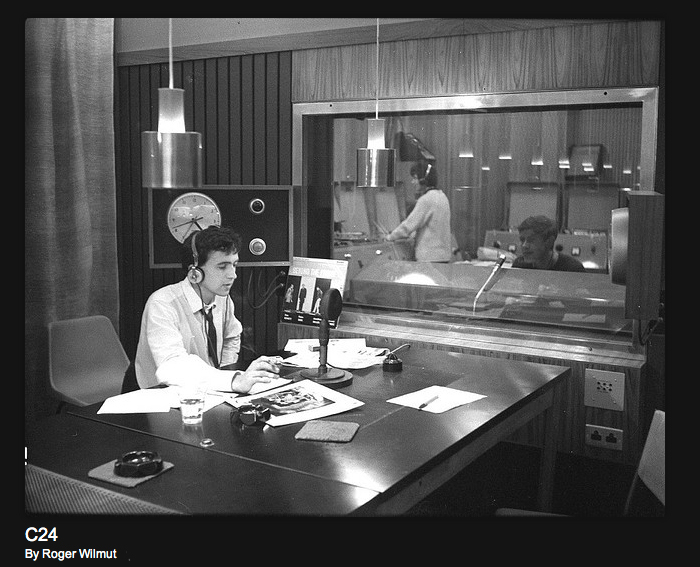
C24 in 1966 - not a real programme, but engineers messing about in the middle of the night.
It's Dave Eckles, who was in Maintenance until he retired a couple of years back. The presenter is John Norman, who left the BBC in 1968 and I've not heard of him since. The grams player is Christina Van Embden, who became an SM and left many years back.
|
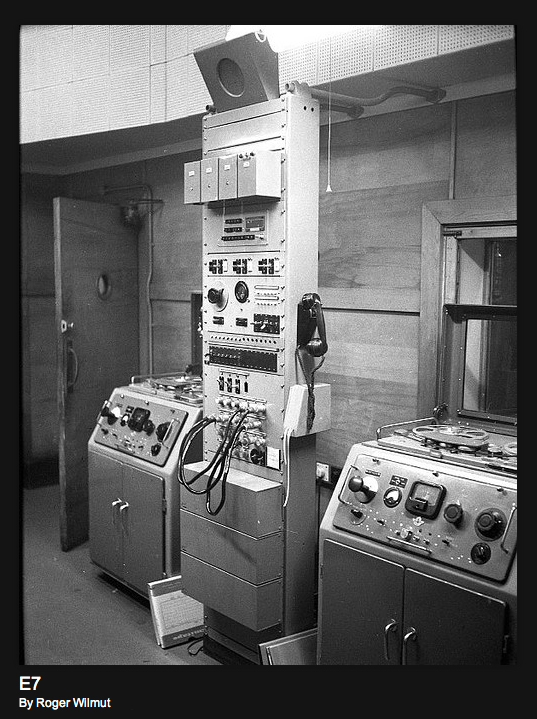
Channel E7, which also had Presto disc-cutters, showing the complex control console with lines to S4.
|
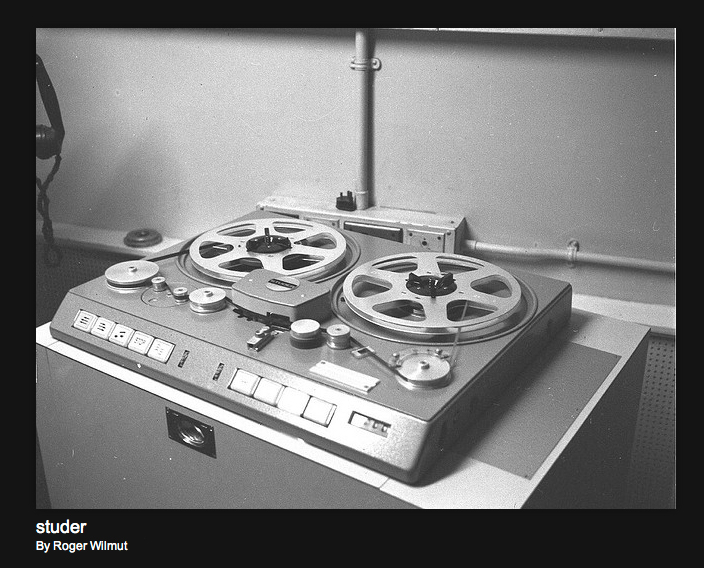
Early model Studer around 1969
|
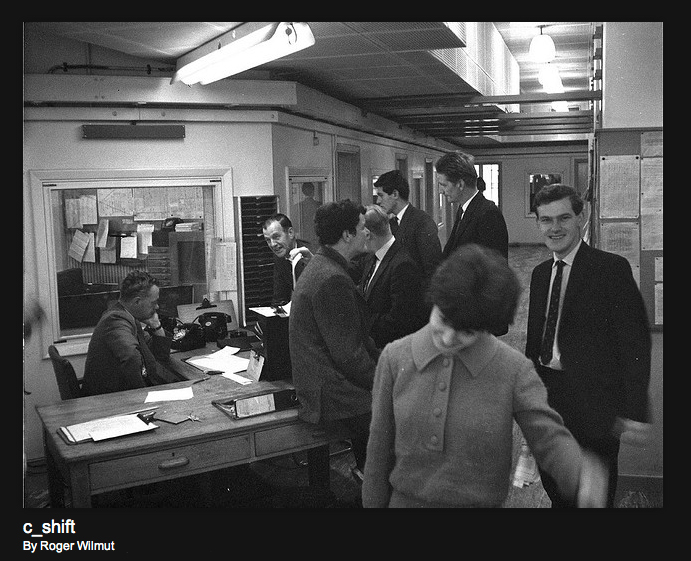
Control Room - C shift arrives for work one morning in 1965
|
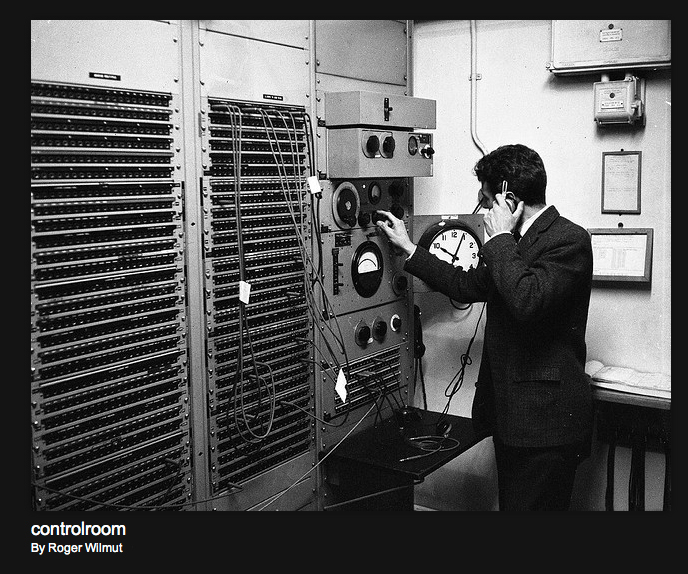
Control Room in 1965: Rex Pitts tests the line to Berlin.
|
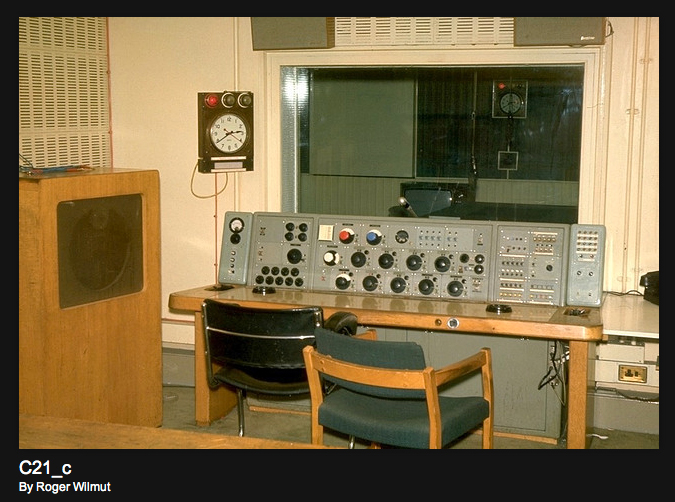
C21 in May 1972, showing the added tape monitoring selector panel on the left and pre-transmission-test unit on the right.
|
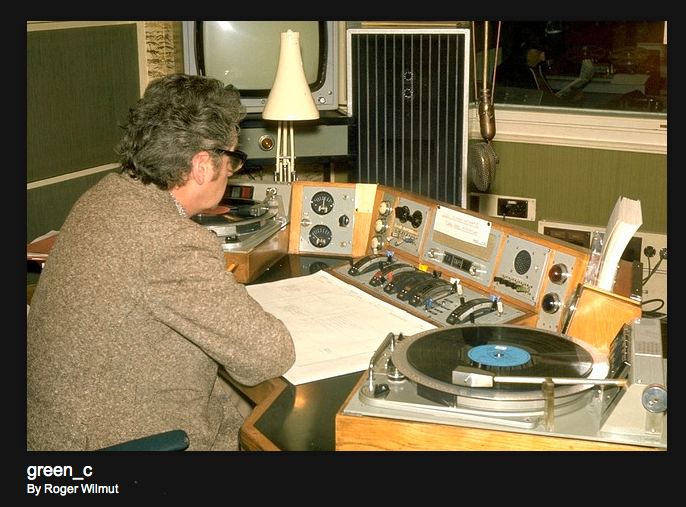
Green Con, the announcer's side, May 1972: the announcer is Arthur Adair.
|
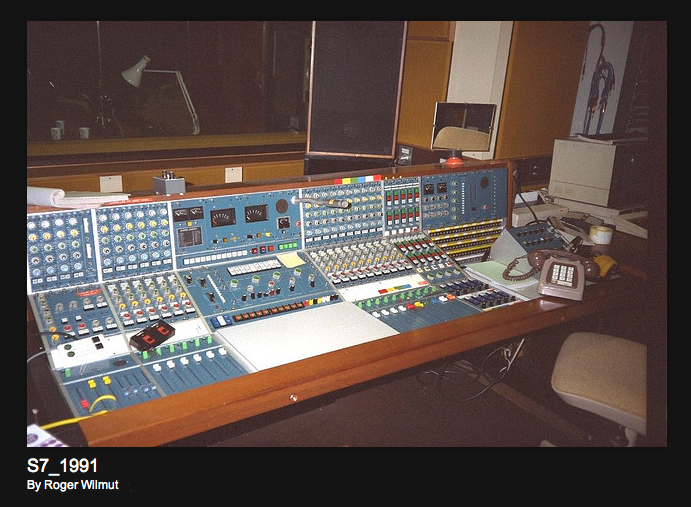
S7 in 1991 (at least I think it is - you can just read the telephone number on the original scan). The coloured faders on the right would be for the phone-in setup, as is the BBC computer just visible on the right-hand edge of the picture. I suppose this desk was replaced by a later model?: note no limiter panel, and the mini-jackfield on the right (these gave so much trouble they were all replaced). The panel above that with the two small meters contains a couple of voiceover units.
Stuart Pinfol - d S7 is now the home of Africa Have Your Say, Fast Track (African sport), and phone-ins in French, Swahili, Dari and Pashto (for Afghanistan), Burmese and Somali.
It's one of the few studios in Bush House to have Phonebox installed, hence the high number of phone-in programmes coming from the studio.
The desk is a Calrec and is similar to this one in C33 which broadcasts Focus On Africa and Network Africa and, pre-Egton House move, BBC Xtra in Arabic:
|
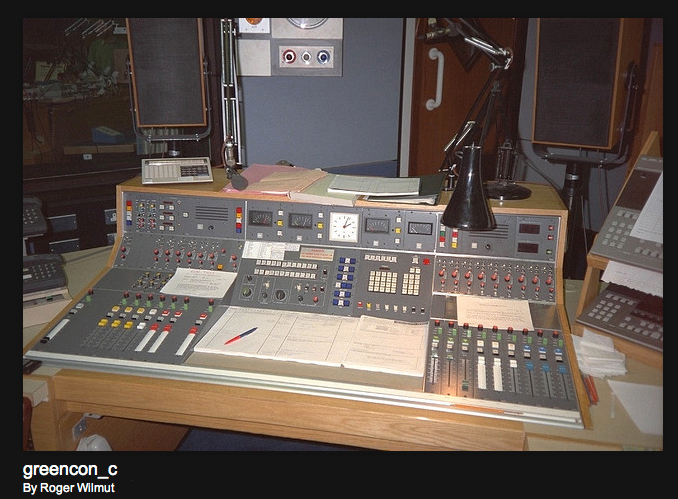
The more recent Green Con desk, taken in the late 1980s.. Both the SM and announcer's desks were identical, and eventually there were periods when the announcer ran the network by themselves. In the end, of course, the network became entirely announcer-operated with the advent of NUMISYS, Bush's first computerised playout system (christened 'Nasty Unreliable Machine Invariably Spoils Your Schedule').
John Howard
Ahh the delights of dabbling in early networked audio playout. I remember we had all sorts of trouble early on because the channel microswitches were pressed into use to start and stop playout from Numisys. Trouble was they needed debouncing for the digital world, I think some NE555s were quickly pressed into service. The first version of software wouldn't let you re-cue a 'played' piece of audio easily. Caused all sorts of trouble.
|
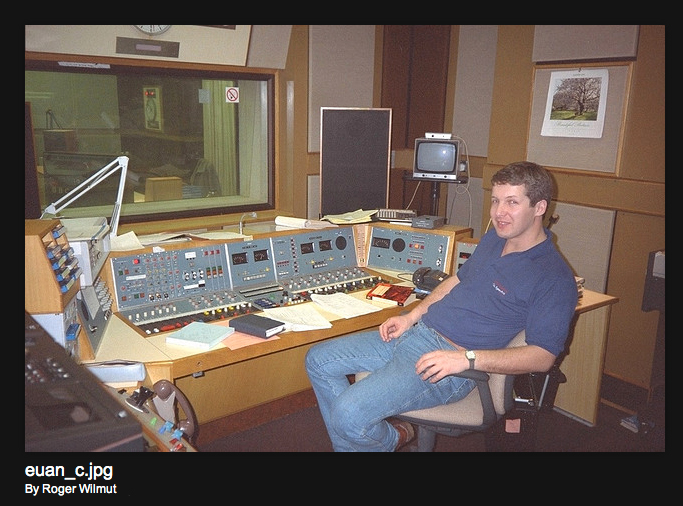
Euan Semple at the ill-fated Tweed Audio Continuity desk - we only had two and then the company went bust. Photo taken some time in the late 1980s
|
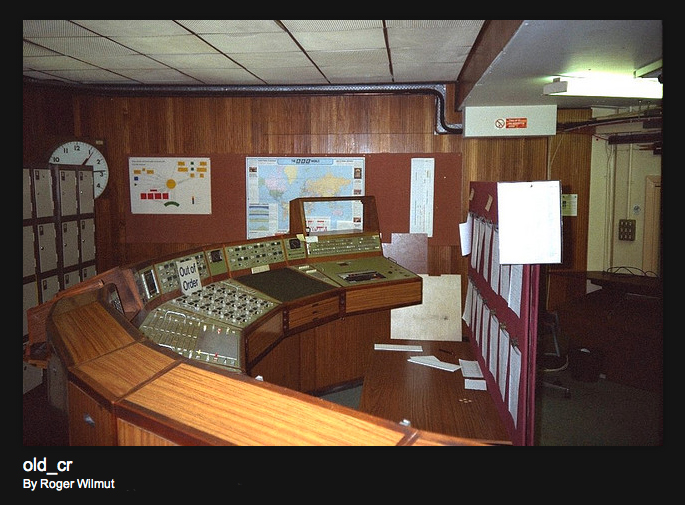
The then recently decommissioned old Control Room in 1991
|
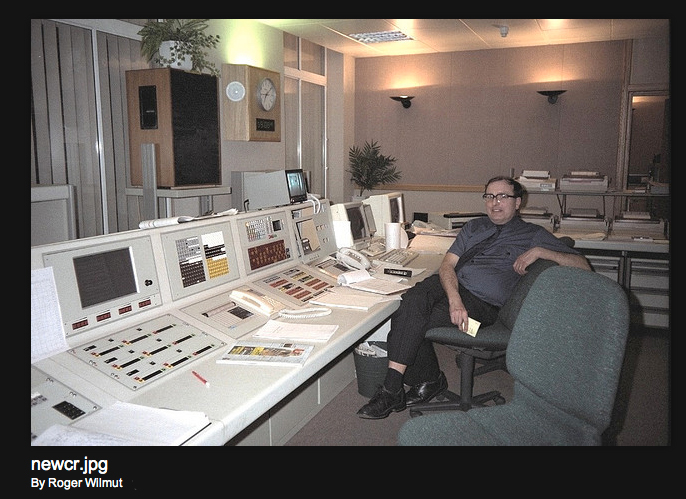
Doug Ricketts in the then brand new Control Room: taken in 1991
|
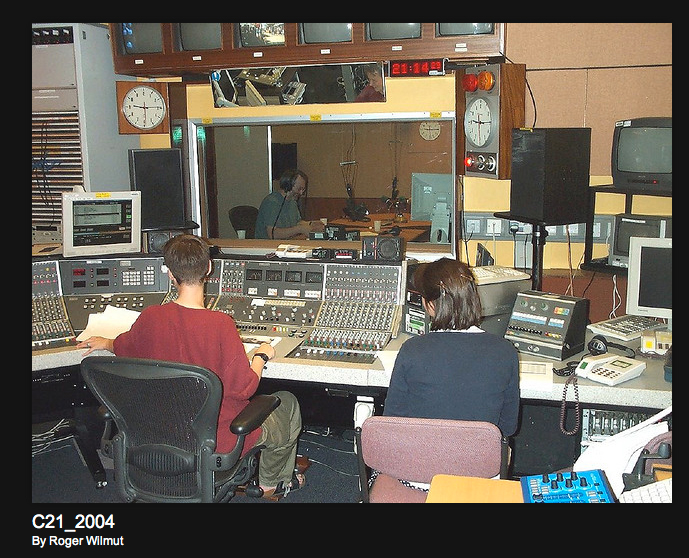
C21 in 2004, just pre-RadioMan. An interesting comparison with the two earlier photos.
|
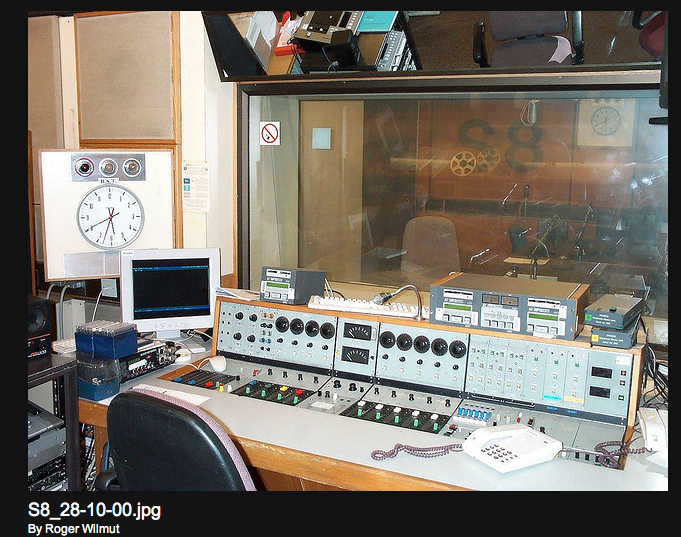
S8, 28-10-00
|
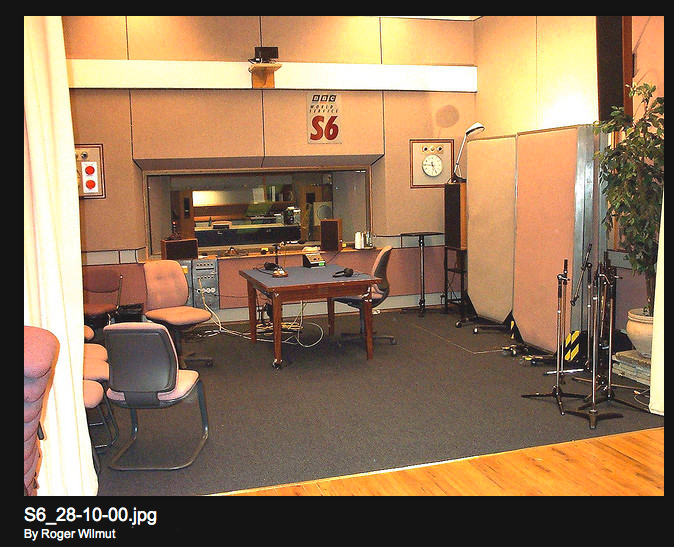
S6 studio 28-10-00
|
|
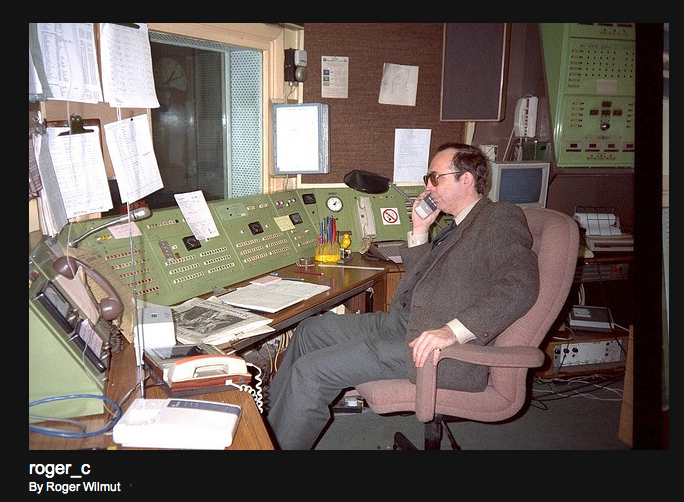
In the spring of 1991 the engineers had moved to a new Control Room, and for a couple of months SMs were decanted to the old Control Room while the second floor offices were refurbished. (I didn't like going to work on the 6th floor: I almost expected to find George Petty, my old TOM, there). Dave Godwin took this picture of me - at that time I was doing DOM reliefs.
|
|
Nagra SN comments by Richard Schiller
Subject: Nagra SN
Date: 05/02/2022 at 15:31 (GMT -6)
Message: Hi. I was reading your piece about the BBC & EMI. I noted a comment regarding the Nagra SN. This was described as not very useful. As I remember, BBC Bush House (BBC External Services) had two units. They were useful. Of all the recording devices available at the time, these were the only ones not to use liquid lubricant - with any degree of quality. This meant that they could record at low temperatures. I believe that the first documentary which brought back animal sounds from the Arctic used Nagra SNs - previously actors would voice the animals. I note that the article suggests that the tape was 1/8 of an inch wide. It wasn't. If I remember, to be able to use the cutters designed for Compact Cassette, the tapes were the same width; 3.81mm.
Richard Schiller
EMI Professional Tape Recorders - Photos with permission from Danny White
"EMI RE 301/E. Super rare EMI tube 1/4" stereo tape machine. Really nice shape and well taken care of. The way I understand it is this is the military version of the EMI TR 52. The only paperwork I got with it stated that it was tested for playback in 2001 and was working. Very heavy and built like a tank. Overall, I would say it's about as good of condition as could be found fifty one years on. EMI made these in 1965." - Danny White (this recorder is not for sale on our site)
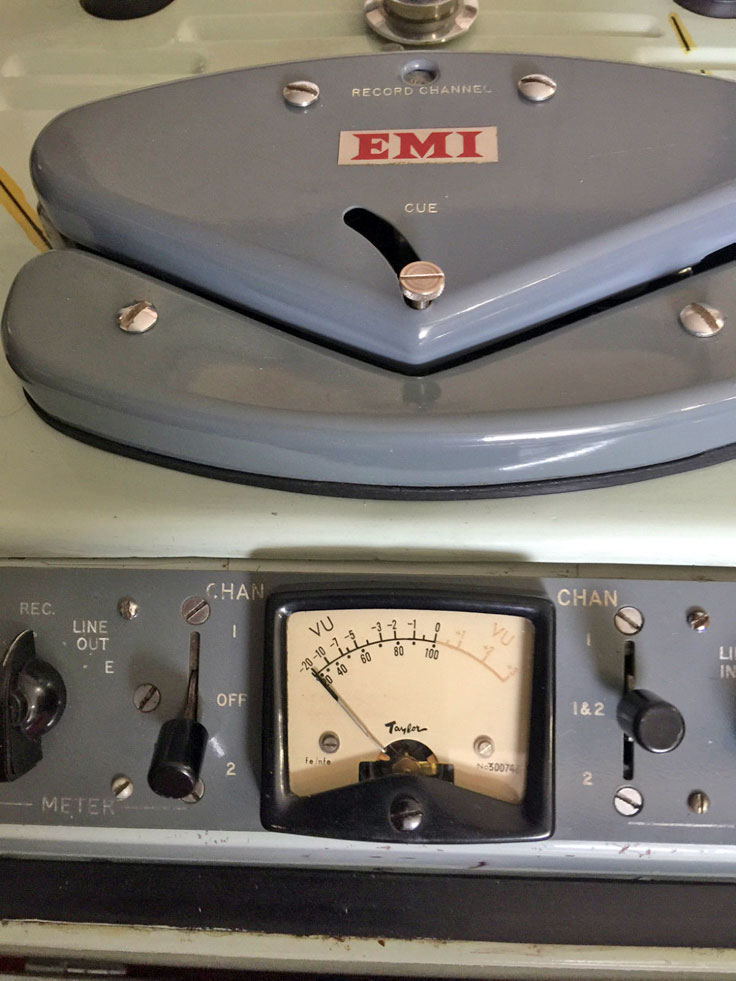
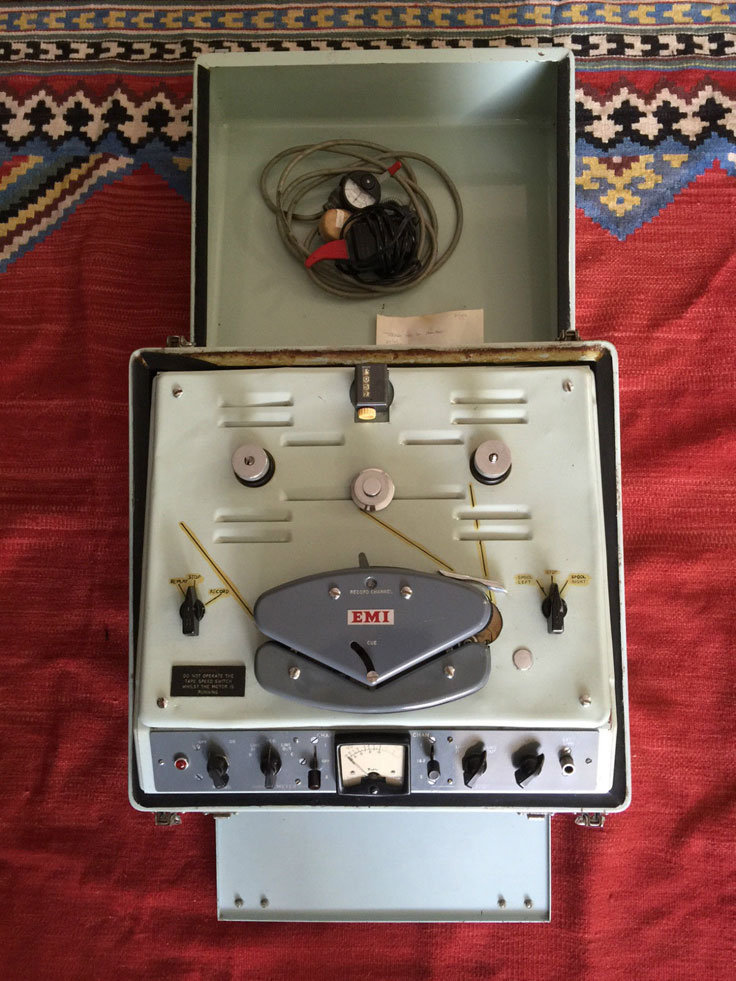

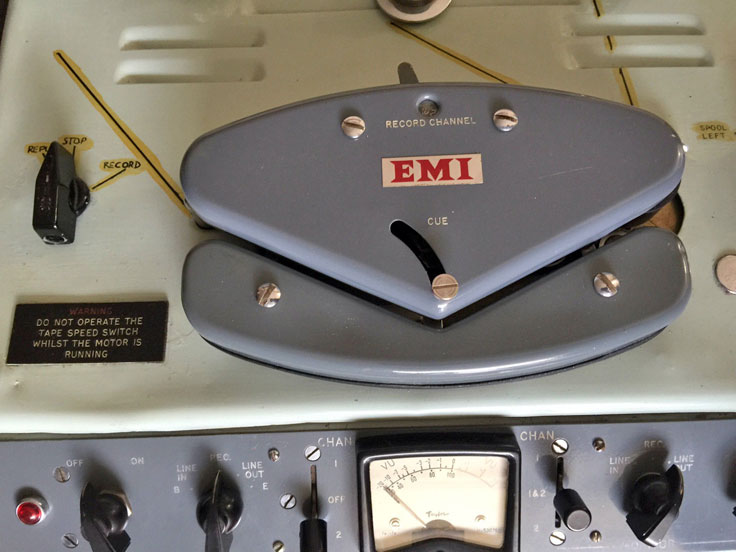


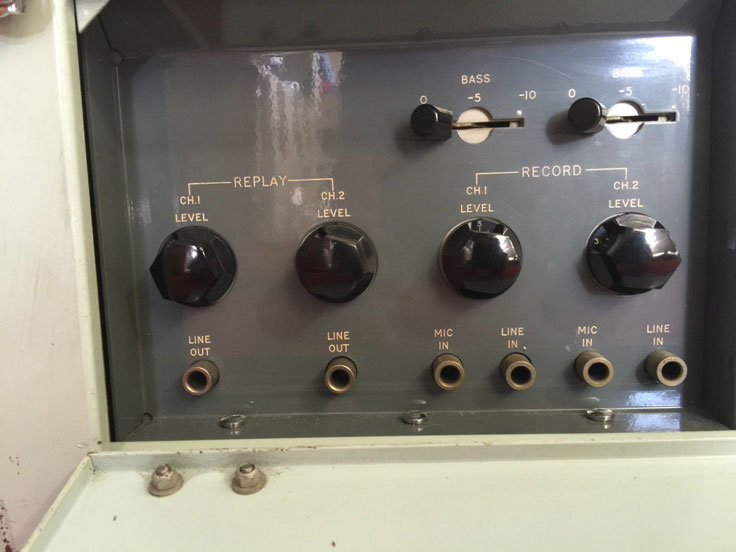
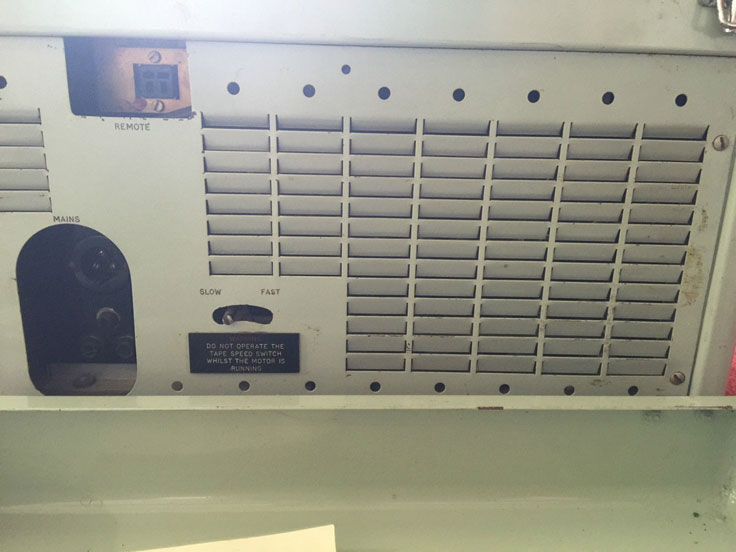
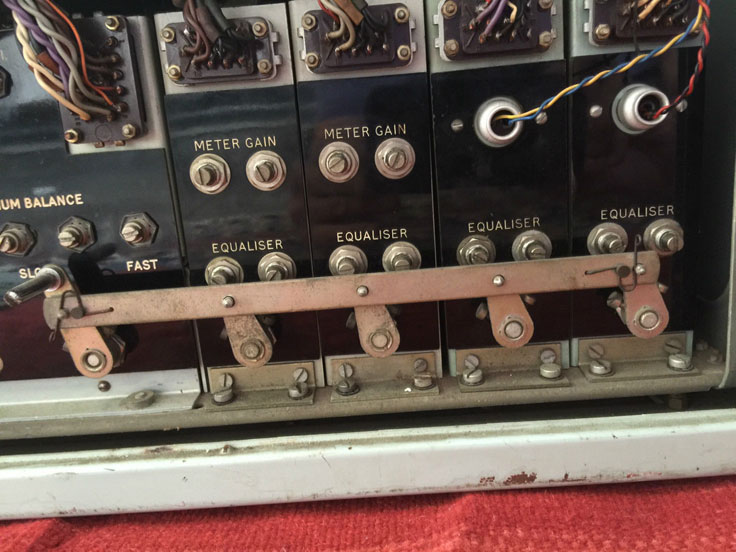
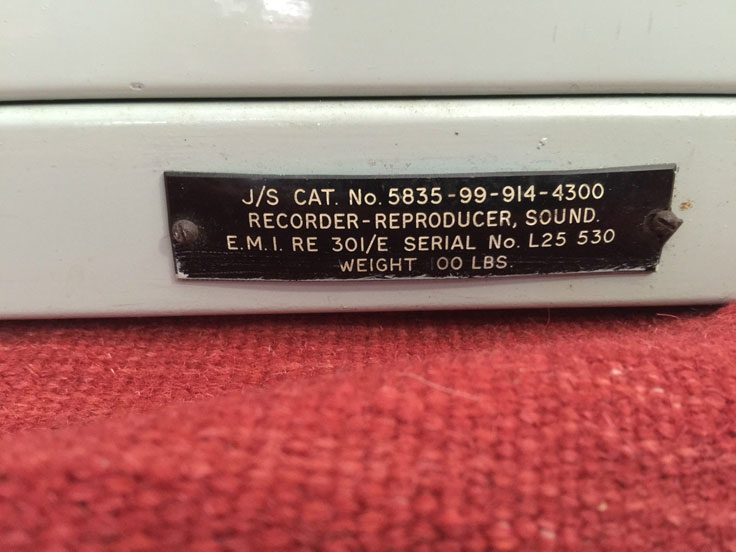


"EMI BTR 4 tube, analog reel to reel tape machine. From recent purchase of private collection in England. The EMI BTR 4 is a Mono 1/4" tape machine. The history of EMI recorders is a storied one in that the BTR (BTR-2) Series was used for the early recordings of The Beatles. These machines were built to very high and exacting standards and were intended to last a lifetime. I believe this machine to be from the early to mid 1960's and is in fantastic condition. These machines are super rare and were made in very small quantities as they were extremely expensive for their day. The EMI tube microphone preamp in this machine alone, is highly sought after as is most anything made by EMI due the the high build quality." - Danny White (this recorder is not for sale on our site)
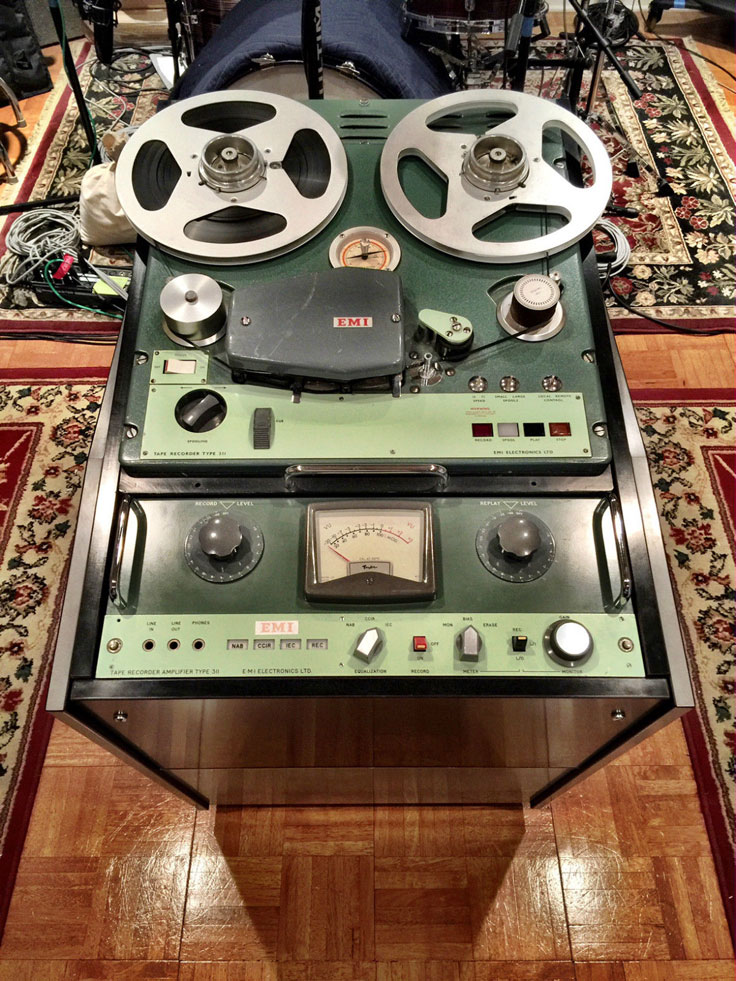

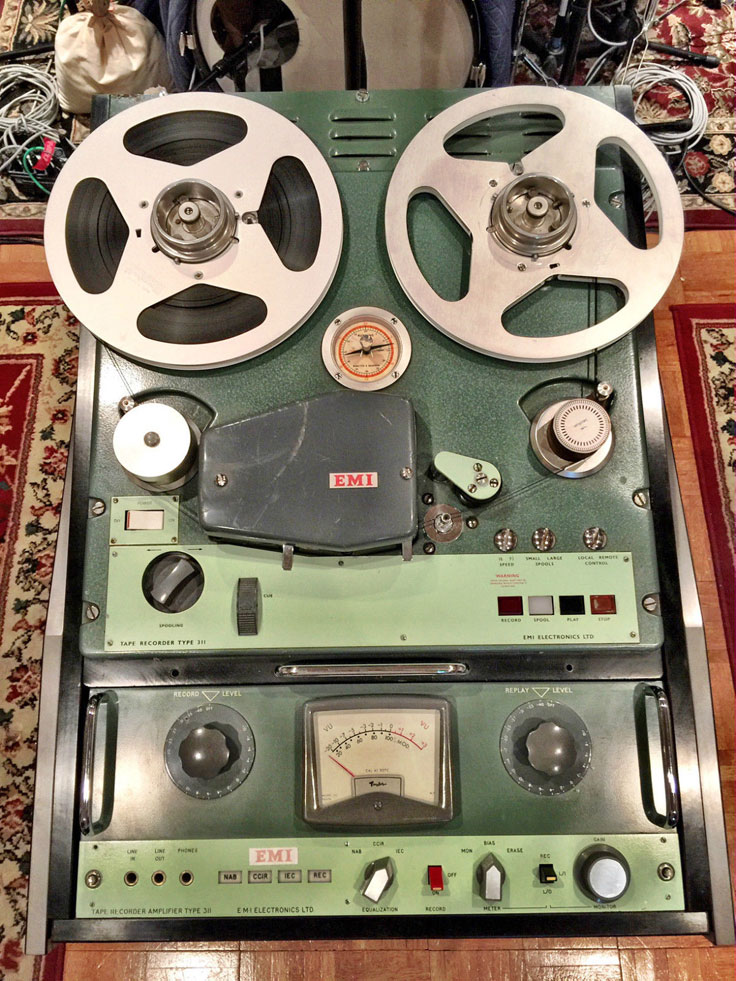

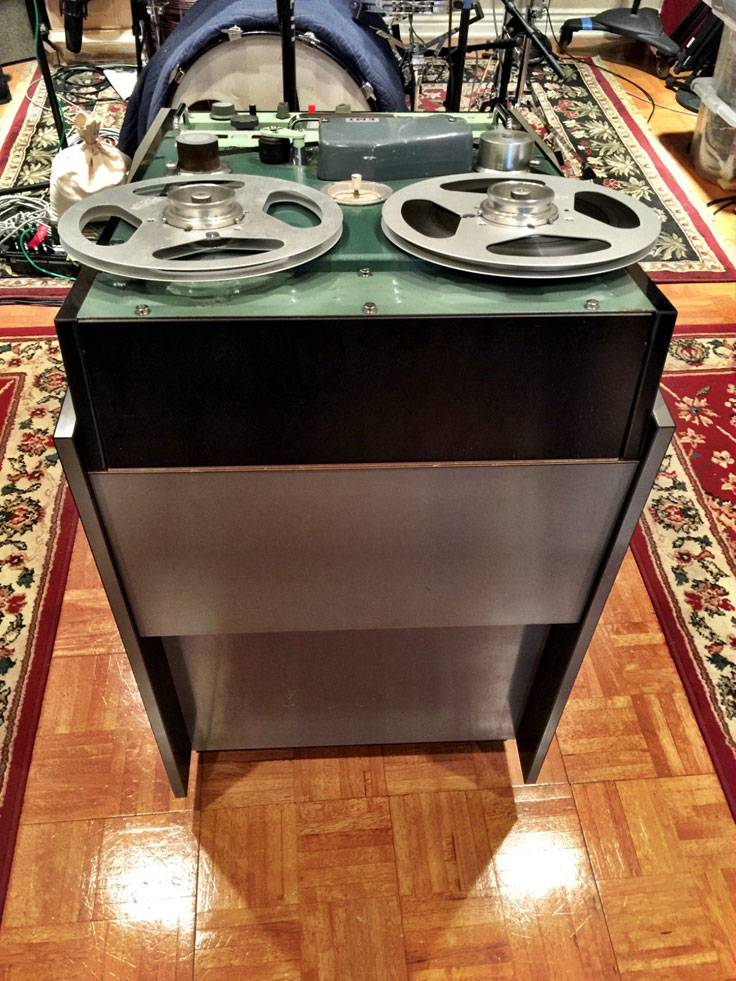
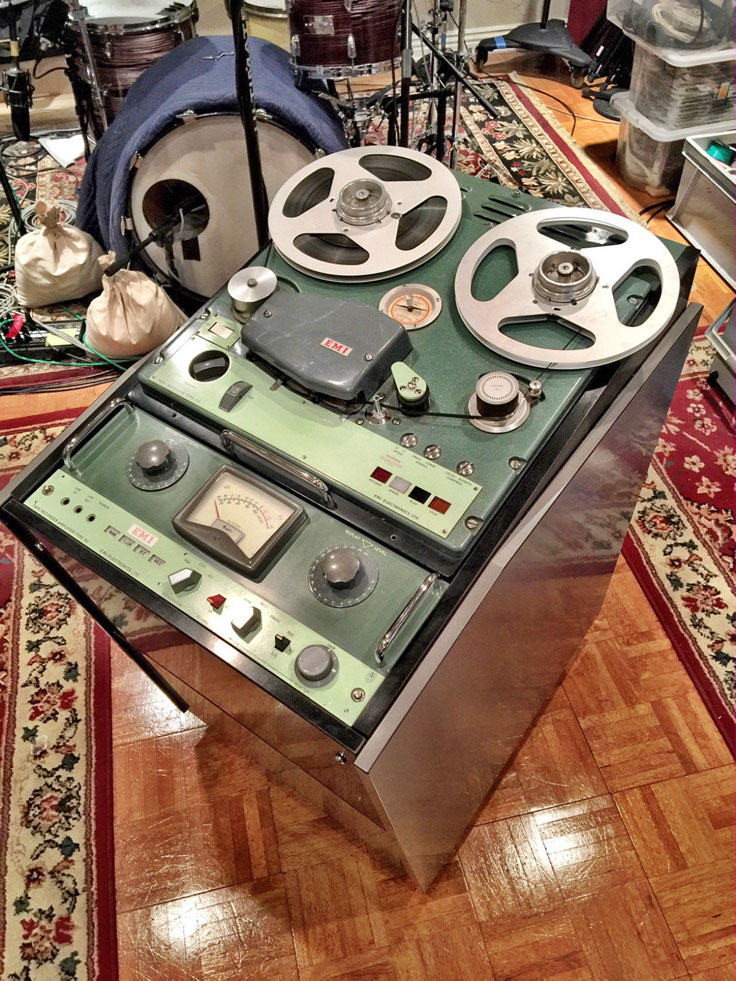
Back to Stories • go to EMI company information

